#I like to implement themes and imagery a lot in my work and this is me putting the back wheels before the cart before the horse
Explore tagged Tumblr posts
Text
.
#I like to implement themes and imagery a lot in my work and this is me putting the back wheels before the cart before the horse#But in those tag games I do sometimes I've always compared Riley to a coyote-- which I think fits#Coyotes are pack animals living in the desert w/ their social systems-- similar to nomad clans living in the desert w/ their social systems#And a coyote's perceived aggressiveness translates well to symbolize a character like my V who has a reputation for being aggressive#The idea of a pack animal separated from it's pack is what I was gunning for#But I never noticed that the dichotomy of coyotes and their stereotypical prey-- jackrabbits-- translates REALLY well to Johnny and V#Especially considering Johnny as a jackrabbit rather than a coyote (backwards I know but work with me for a sec)#Jackrabbits being a solitary animal that CAN live in a group but usually chooses not to#The idea of a hare looking similar to a rabbit but still being prey all the same#(idk why but my brain sticks with idea of Johnny standing out from the NC Vox Poppili but he's still just that at the end of the day-- prey#And running. Running at danger running for safety. The thought of Johnny always always always running#A jackrabbit can't move slowly they're often symbols of moving fast-- Johnny never slows down; he's always on the run from something#With the Coyote chasing after it for survival#In Dine mythology the coyote and the jackrabbit are both trickster figures and idk that sticks in my mind#Coyote wants to smoke Rabbit out of it's hole but when it lights the fires Rabbit kicks the embers back into his face#Cunning beaten with cunning in a sense like two sides of the same coin. Idk it just tickles me#The idea of two people both being so opposed but still having that emotional connection between them#Anyway thought blurb over#Honestly I'd've made this into an actual post but my thoughts aren't necessarily in the best order for it
4 notes
·
View notes
Text
Dawntrail Retrospective
Okay, it's been two weeks since Dawntrail launched, a bit over a week since I've cleared it and have had time to think things over, wanted to do a big dump of my thoughts, a non-scored review of it all.
Full spoilers after the break.
So, I want to give this all a nuanced look; I know this has been a polarizing expansion; I did very much enjoy my time while still having some qualms, and I'll try to highlight both sides of that here.
Overall, while it would be low in my expansion rankings, that's not to say it's bad. Just as I probably bump Heavensward up a bit in my rankings because it did so much with so little (in terms of budget, gameplay tools available, story to build on, cast, etc.), Dawntrail takes a hit because I know what they're capable of these days.
But a 10 year saga is a tough act to follow, and I know if this was my first FFXIV experience (it might be a lot of people's one day, if the 'second saga starting point' for new players they mentioned ever gets implemented), I'd be going 'oh wow'.
Anyways, before I pick things apart, I'd like to highlight what really worked for me.
Sphene was my problematic fave. I know Artificial Intelligence tropes can be overdone, but I have a fondness for them because when done right, an AI is clearly authored by someone. Just like a biography, even an autobiography, paints the subject in a certain way, an AI really reflects the creators' biases.
Just as the soul technology was shown as a mechanical version of the aetherial sea, Sphene really felt like a sort of digital primal for Alexandria, the people's desires latched on to her, sort of a vtuber Zodiark.
I loved the development that her compassionate personality (taken from the OG Sphene) was distinctly incompatible with her unsustainable primary directive, protecting and preserving Alexandria's way of life (the directive from the people)
And I appreciated that part of the thesis statement of her character is "a Garnet who never traveled with Zidane would become a tool of Alexandria, her kindness taken advantage of as a figurehead''. Which makes it nice when Wuk Lamat breaks through during The Interphos to appeal to her.
She can feel like a bit of a rehash of Hades and Metion, but I do enjoy the contrast of her valuing life too much to Metion not valuing it enough; it's important to know how to live in spite of despair, but it's also important to accept that even memory is not forever.
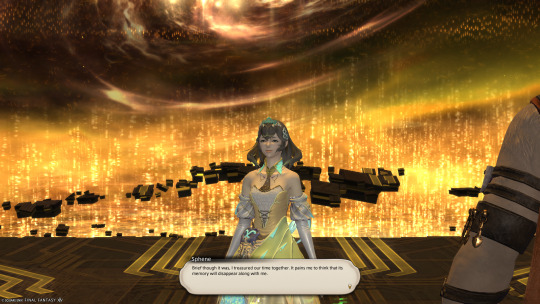
Also while I'm here I have to say I absolutely respect the zone change of Living Memory from stunningly beautiful to hauntingly somber. I hope that change is not reverted in patches, as it's absolutely the starkest environment change in the game.
I like the idea of casting aside nostalgia to care for the living, and I thought this zone was a welcome surprise from the "Golden City" imagery a South and Central American expansion invokes.
(PS, massive Simulated Twilight Town vibes)
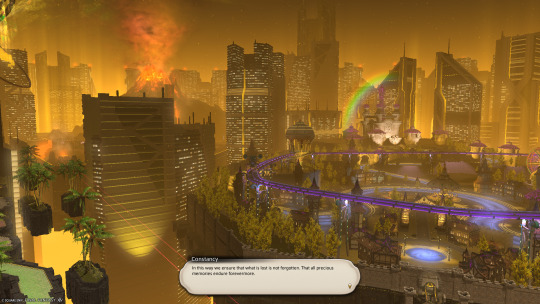
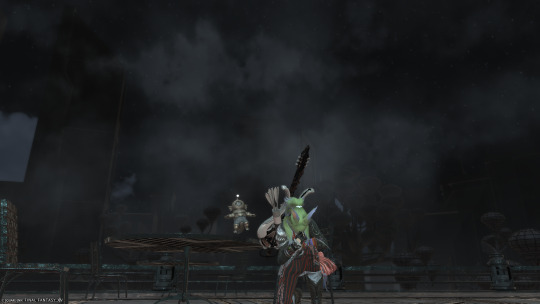
And I thought Cachuia was well done in this zone; I was a bit antsy earlier with how they made her into just a drone, but I liked the resolution between her and Erenvelle
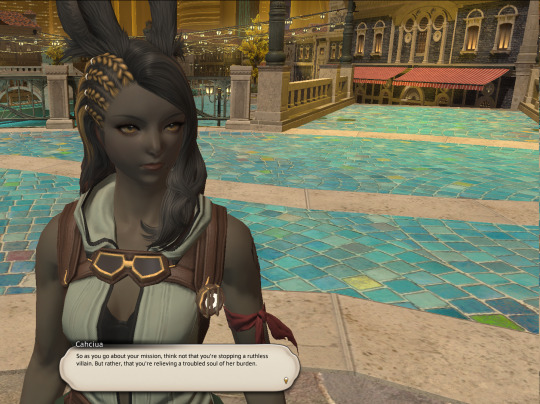
But one thing I want to stress as I sing the praises of the last zone and change, is that neither half of this expansion works without the other, because unlike other split expansions (SB having the Gyr Albania and Yanxia halves, EW having Islabard then the Ancients), it felt clear in why it had both halves, and that was for the contrast of the same theme, Namely, the ideas of culture, tradition, and history, and how they affect the living.
When Wuk Lamat is giving her speech during her ceremony, she notes one of the societies taught her "they believe death is not the end, and we live on so long as we are remembered", which Sphene says almost verbatim of her people later, menacingly polite as that same belief is twisted.
There are some roots of this conflict in the first half too, with Koana's disinterest in culture and tradition, before realizing progress and culture weren't incompatible.
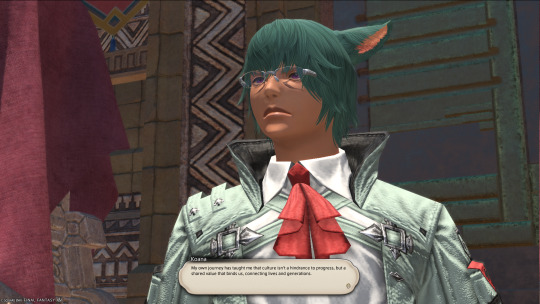
While Alexandria instead takes it to a logical, Black Mirror extreme, discarding culture and history, literally forgetting anyone who passes (while assuring themselves anyone who is lost still lives on) and living purely in the present moment; death itself removed from the public circle.
I don't think the Alexandria half, the modern, present-focused society works without first setting up a region with a rich culture and history.
In the first few regions, you see how those who walked before led those who walked after, while in Heritage Found... you see a heritage lost. On both sides of the divider there are abandoned buildings; a sidequest in the graveyard has the keeper note that memorials have fallen out of favor due to regulators, Alexandria had a perfect record of history (data, people, all stored in the cloud), but didn't use it; specifically keeping it away to prevent painful memories from affecting the present. While Yok Tural had an imperfect history (a lot in legends, retold/inconsistent oral history), but that history distinctly affected their day to day; even the painful memories, the tragedies, all played a part in shaping the present.
Even though it could make the pacing clunky at times, I did like that Wuk Lamat's basic setup of "learn about these people and understand why they make the choices they do" extended to Solution Nine and even Living Memory.
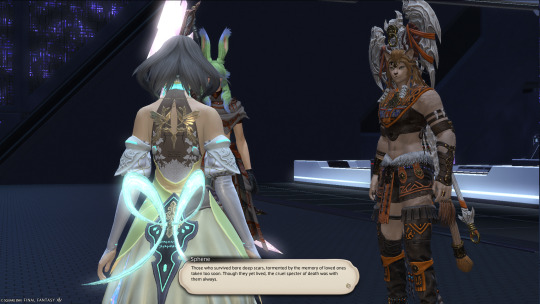
Garool Jaja was also a very good character, loved his performance, do kinda wish his solo duty where he confides the true nature of the contest was the very start of the expansion; I feel like it would have set the tone for this being the "The WoL is a mentor arc" better.
Also to wrap up the good side: every single dungeon and trial was ace. Dungeons finally hit a good level of difficulty for normal content, and were well designed and very pretty. Vanguard and Everkeep in particular were delights, as was the postgame dungeon Tender Valley.
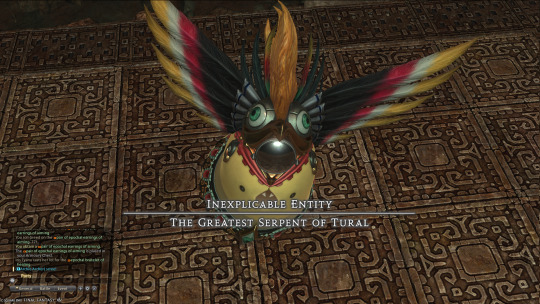
------------------------------------------------------------------
And on to my more mixed feelings.
Wuk Lamat- I don't hate her, but I don't like her that much either. I tried to keep an open mind for the full MSQ, but ultimately she's not a character I really vibed with; I do get the shonen protag/Naruto appeal, but it's really not for me. She's been described as 'Lyse 2.0', and while I admit I have similar feelings about Lyse, I do think Wuk Lamat has a more natural progression. Lyse started Stormblood feeling like a 20 something on a mission trip, while Wuk Lamat feels like a reasonable candidate who just needs a little encouragement.
I don't mind too much our WoL taking a mentor role and taking a backseat, while downplaying their powers; but what I struggled most with was fatigue. Wuk Lamat was always there, like the memes of "Talk to Wuk Lamat" say. Like Shadowbringers was the expansion where Graha was the main character, and a lot of the time he was away doing city stuff or being mysterious. Wuk Lamat would have benefited from more time to breathe, especially in the back half of the game. She should still be there in the back half for sure, for the expansion to work she needs to be a player in all this, but I'll admit I sighed when I got to Solution Nine thinking I'd explore by myself (probably bumping into her at one of the locations) but instead needed to escort her. As I noted earlier, I don't mind the Interphos interruption (though I did appreciate the chance for the WoL to be at full strength) because Wuk Lamat appealing to Sphene's humanity fit the expansion themes well.
Succession- I'm happy this didn't go into my worst fear: a retread of the Azim Steppe where we actively interfere in another nation's politics by being their champion; but it left a bit to be desired. Notably, while I knew the Scion Civil War was a bit of a misdirect, it felt kinda pointless? Like Thancred and Urianger are here helping an alumni from their university out as he applies for the same job, but they're totally chill with you. And honestly there are no stakes to him getting the job, he's the only other qualified candidate to the point where you hire him later yourself.
I didn't want any longstanding inter-scion conflict, but for a character as frequently duplicitous as Urianger and driven as Thancred it just felt like a waste.
Also, GJJ clearly told the WoL that the keystones didn't determine the victor; he would pick a successor that was worthy- I kinda wish they just stuck to that. Having the "good' rulers and "bad" rulers paired together for the cooking challenge felt like a bit of a cop-out, , plus needing to win back a stolen keystone, etc. just felt like missed opportunities.
Zarool Ja and Bakool Jaja - I get what they were going for in the end with each of these: ZJ being the "impossible son of an impossible son, the weight of expectations causing him to shun those around him, and that loneliness twisting him", BJJ being desperate to help his people, feeling the major survivors guilt of his own life costing so many others.
but neither of their narrative arcs are smooth, and in the first half, especially during the trial, they seem to be doing comically evil Wacky Races Dick Dastardly behavior with no regards for a continuous arc. BJJ releasing Valigarmanda was the icing on the cake for me. He could have done this in a reasonable way, weakening the seal in an attempt to sabotage the trial, then feeling guilt over what he did in desperation, but no he walked up to the gate keepers like 'no I'm evil, I'm gonna destroy that now' any hints of ZJ sympathy come like, during his trial and from the Wandering Minstrel, who even notes most will see him as a one dimensional tyrant

I also think they could have distinguished both more from just being warmongers; in the same way that Wuk Lamat and Koana are somewhat aligned but have different visions, personally it would have made more sense to me if BJJ had a different brand of conservatism; putting a stronger emphasis on defense and isolationism rather than world conquest. It would fit his background better too, as someone who wanted to protect his homeland
--------------------------------------------------------------------
My most negative thoughts are really just pacing. I would like to not have so many quests just running around talking to people, not learning much of note. I know there are only so many things you can do (stand in purple cloud and kill 3 enemies isn't great either), but at this point I'd honestly just take a shorter MSQ if it meant better story pacing.
I know the first half is meant to be like an abbreviated ARR, and I don't mind it being low stakes, just wish it had a bit more polish.
I will also say I felt a lot more limited in my dialog at times? Like I don't need every box to have "I'll kill your god if I have to, maybe even if I don't", but there felt like a lot of instances where you had two ways to say the same sentiment. I like it when the game lets you have opinions, even if the opinions are objectively bad (you can straight up tell Noah the Allagans were visionaries) A lot of that pacing was more actual story content than the quests though; the first three zones could feel like extended allied society quests (solid enough ones), which wasn't bad for a 'fresh start', but Shalooni is where things felt off. I liked the vibes but frankly the quests left barely any impressions at all.
(loved the trolley dig though)

------------------------------------------------------------------
Overall, like I said, I enjoyed my time. While it may not be a favorite expansion, it sets a good baseline for another ten years, and I hope they can refine it in the patch series and beyond.
There's a lot more I could probably say, I realized I didn't have a chance to touch on Erenvelle (very glad he tagged along) and Krile; but I feel I'll have more thoughts on both of their plotlines after the patch series.
P.S. though I rolled my eyes at some of the running jokes I genuinely got a chuckle out of Wuk Evu always freaking out then snapping back to polite with "well I won't overthink it then" and similar. Felt very Chocobo Racing GP.
P.P.S. Wood-carved owl nouliths are the best idea. A+ weapon.
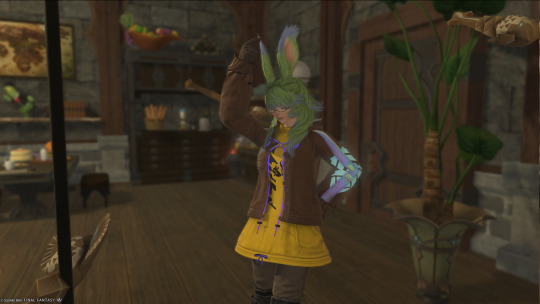
26 notes
·
View notes
Text
tadc works better in the medium that it unintentionally conveyed itself as
okay. you’re probably reading this title thinking “but subwayfloorlicker1978… what IS the medium in question????” okay the medium in question is being a lore filled mysterious series with twists and turns and having an emphasis on twists and turns just as much as its characters.
now. this baffles me a little bit bc even though one could get that exact idea of tadc just by watching the first episode (and the fandom ITSELF literally got that impression. i mean its even evident in the fanmade aus.) gooseworx made a twitter post a few months ago that apparently tadc is made up of. and i quote. 95% character depth/stuff/etc and like 5% of lore. which is… hm.
which also baffled me! because my GOD was there a lot of lore foreshadowing and spooky (if you want to call it that.) stuff throughout episode 1. like WAY too much of it, especially if your main goal of tadc is to have it be a series centered heavily on the characters. not saying you can’t have background plot things going on, but like… 95%? seriously? i’m definitely praying she hadn’t entirely thought out that ratio before pressing the post button.
and that’s why tadc unintentionally comes across as a series with super deep lore, literally to the point where i’ve seen certain people unironically call it a horror series (which is wrong btw. even if you’re taking the c&a scenes + caine’s suspicious moments into account). it quite literally spends like 1/3 of its main scenes in episode 1 putting SO much emphasis on the c&a lore and the abstraction and everything else.
and the thing is. i dont entirely blame gooseworx for this. obviously it would be very important to flesh out the environment/world that the characters are in during the first episode (LITERALLY your first impression), which obviously includes locations like the lore office area pomni was in or the cellar where caine banishes all of the crazy people to go to. (oh and also even the topic of abstraction itself via kaufmo) but like..... there’s a reason why tadc has a game theory episode.
i’ve said this before and ill say it again. tadc and the entire “digital circus” thing and the implementation of vr headsets + lore into the story is ONLY an excuse for gooseworx to tell a compelling story about compelling characters in a cartoony wacky environment. its basically a guaranteed way for the viewers to actually see these goofy characters in a humanoid manner. however… you can’t just implement characters with these vr headset backstories and existential themes without it sounding entirely ominous. AND you can’t just drop a huge bombshell regarding the lore of the show and WHY the vr stuff happened and then go on twitter and say that its 95% about the characters.
and with the direction of the cellar and office scenes.. im not sure if it’s even possible for someone to make a clean cut resolution to the lore tidbits while still fulfilling the “5%” lore thing and not having it come off as giving off the wrong expectations. the direction of these scenes is SO intense like. some of these camera shots clearly put emphasis on small little details and the tone of these scenes pale so much in comparison to previous scenes that it catches you so off guard.
which is what makes them very well written! however they pack so much content and foreshadowing into themselves that its such a far fetched thing to say that only 5% of lore will make up tadc. that combined with the prospect of past lives. and also with the clear foreshadowing of jax being a morally corrupt person. what about the extremely heavy motifs of exit doors? there’s no way THATS going to just be gone after episode 1. goose, what do you MEAN there’s going to be corpse imagery? all of this ties into each other. lore and tone tie into each other too. come on.
but these aspects can definitely be used to craft a great story. WITH character arcs and character deep dives throughout episodes. gravity falls literally nailed this. and theoretically tadc could too. emphasis on theoretically.
also if the “memory loss” thing was actually canon and not something the fandom thought was canon (again reasonable misinterpretation because obviously if you hear pomni say “HOLY FLIP I FORGOT MY OWN NAME!!!” you’re going to assume she forgot everything else.) that would also work well along with the theoretical lore stuff if it was more emphasized. literally think of the vast opportunities for foreshadowing. maybe pomni finds out something about the other characters via revisiting the office that THEY can’t remember. maybe do something with like… reflexes and muscle memory or something related to “the mind forgets but the body remembers”. maybe use it as a plot point in relation to jax’s keys or his weirdly implied secret or something. IDK! i just think a lore and plot driven story in this environment combined with character things (50/50…) would be marginally more interesting than what we will be given.
okay one more pet peeve in relation to this before i go. deep breath……. i really hate the cartoonish body language of the main human cast. GO AHEAD BOO ME. THROW TOMATOES AT ME. LET ME EXPLAIN OKAY.
one piece of media that i think does a GREAT job when it comes to utilizing body language in storytelling is duck season. it clearly humanizes the guy in the suit by giving him certain habits that seem undoubtedly human and make him feel very… alive. like whenever he smokes a cigarette but then quickly puts it out when the player gets near him bc he’s startled and needs to keep up a facade. like THAT. that’s what strikes me as a human behavior.
so if goose’s goal would be to humanize these “cartoon” characters… realistic body language that clashes with their digital circus designs would be a perfect way to make them stick out in comparison to the npcs or caine and bring out the fact that they’re humans in an environment curated by nonhumans. it would also help a little more with tadc’s target demographic problem i think? the characters having little humanoid habits would make it seem a little more mature i think and would also go well with my idea of theoretical lore-focused tadc. not saying 20 year olds CANT be into pieces of media that have bright colors and are very cartoony. im just saying. there’s a reason why there’s so much content slop of tadc.
#tadc#digital circus#tadc pomni#the amazing digital circus#gooseworx#tadc jax#pomni#the amazing digital circus jax#cue the loudest sigh….. however i am definitely still pumped for the next episode#oh and also the coooool super mysterious cool mystery behind jax’s character. he genuinely intrigues me a little tiny bit#my rants
12 notes
·
View notes
Text
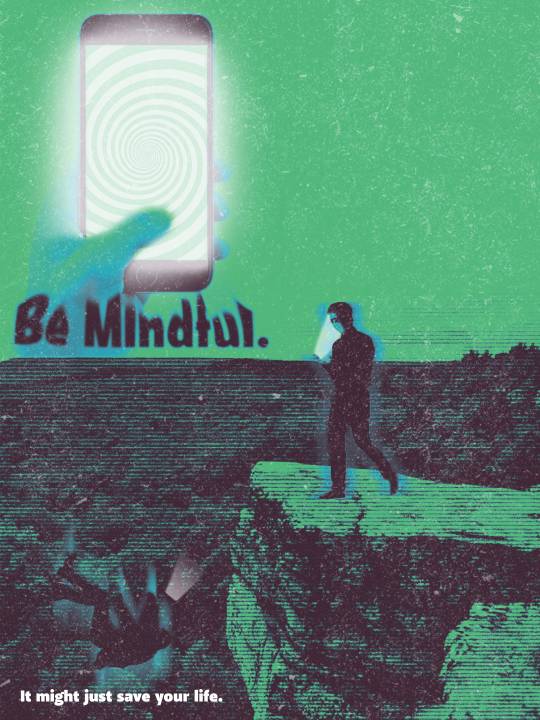

So far, this week has gone very well. We were assigned to create a poster with a theme of "mindful." I immediately knew what I wanted to do, so I made a couple of sketches and went with it. While I was pretty happy with the first design, I received some feedback from my professor that really improved the design. Punching in on the character and ditching some distracting imagery made the design more effective as a whole. I'm not completely set on the sky imagery or the text, and I feel that stars in the night sky would fit the vibe of the poster a bit better. I'm very excited to see where this ends up, and I may even create a personal line of different posters themed similarly.
For the video that we watched this week on Paula Scher's episode of Abstract, I felt incredibly interested, and it was by far my favorite video assignment of the year. The way she describes type is not only understandable but also very informative, and I felt like I learned a lot of different ways to see type and implement it in future projects. I also felt like her range of work was very impressive, with works ranging from complex to very simple, and they all felt extremely correct in the way that they represented what they were being designed for.
2 notes
·
View notes
Note
WAIT DID ANYONE EVER ASK U ABOUT UR YURI ON ICE AU COS IF NOT PLS SPILL I LOVE SSKK AND YOI AND I SHOWED UR DRAWING TO MY BESTIE COS I WAS SO EXCITED I NEED TO KNOW MORE!!!!
AHHGHF SORRY THIS TOOK SO LONG, THE YOI AU IS A BIG INCOHERENT MESS SO I STRUGGLED TO PUT IT INTO WORDS <//3
THIS IS ALSO SUCH A LONG REPLY BC I JUST. RAMBLE. I AM SO SORRY IF THIS MAKES NO SENSE, IT IS ABSOLUTELY ALL OVER THE PLACE-
Okay! So I really really love the AU, but sadly there's no cohesive plot to follow if we're gonna be honest- I have a few points, like the banquet I changed up, and Akutagawa's appearance as Atsushi's coach is also changed, but other than that I really just have this to draw connections and put sskk in silly little YoI scenarios </3
I tried real hard to match BSD characters to YoI but it was just not working for me [I've been messing with this AU for like, a year after all] Even deciding between Akutagawa and Atsushi as who would be Viktor and Yuuri was a bit complicated, bc I personally think it has potential either way. The obvious, and generally more fitting choice is the one I went with ofc, but I think a version where Atsushi is Akutagawa's coach would be just as interesting!
Anyway, despite being mostly just for kicks, I still tried to put thought into it!
With how Yuuri was constantly surprising and surpassing Viktor's expectations, I figured Akutagawa's ability to surprise Atsushi with his actions would work well. [Also because I think the scene in the parking lot where Viktor tells Yuuri he'll resign as his coach if he doesn't make it to the podium is very reminiscent of the scene in s3 with the imagery of Akutagawa shattering from Atsushi's reckless words-] But again, Akutagawa as Viktor works just as well since Yuuri says in the very first episode that Viktor never ceased to surprise him, if we're going that route. As well as the fact that both sskk and Viktuuri learn from each other throughout their respective journeys together.
Like Atsushi's 2 costumes being based around his ADA design/The Tiger, and Beast, or Akutagawa having a lighter coat/his overall main design being a lot brighter to symbolize the change from yk, the Mafia in canon. I also threw in the Ch88 themed look for Akutagawa's younger version because I wanted to draw Akutagawa with longer hair, but the design itself is supposed to symbolize a sort of 'end' to his skating. Since Viktor begins to lose inspiration further down the line until meeting Yuuri, that's what I'm trying to implement with the design. If that makes any sense-
Since Akutagawa in canon had been searching for worthy opponents as a way to gain Dazai's approval, when he finally met his match against Atsushi he was practically thrilled [for lack of better words/to put it simply--] So I'm taking that idea and throwing it into this AU as Akutagawa gaining back his passion for skating when he sees the potential in Atsushi even despite his loss at the GPF. Speaking of, the banquet also goes a bit differently-
I figured stripping and pole dancing wasn't really Atsushi's style, I don't know how to explain it so I might doodle it sometime, but I have this old ass screenshot of me talking about this AU to mildly sum it up
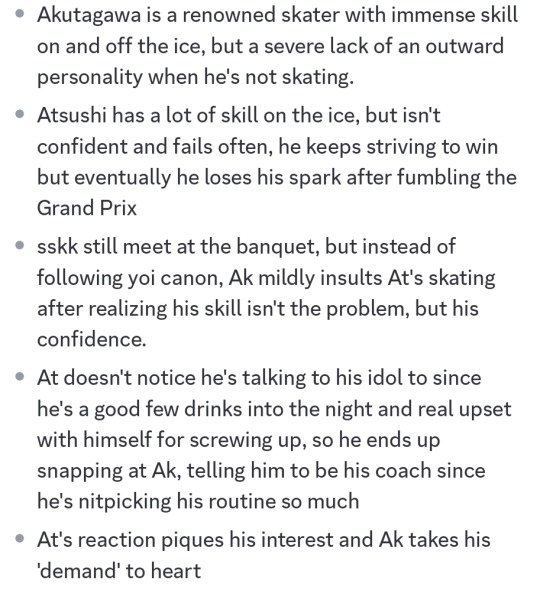
And going back to Atsushi's 1st costume being ADA themed, I wanted that to tie into Yuuri's first program being about his career and life, and the love he has for the people who stuck by him through everything. The ADA is kind of a perfect example for that, I mean, Atsushi's entire uniform was given to him by each member so I figured it was a perfect parallel. Although there really isn't a tie between the Beast costume and Yuuri's Eros program though- That was just for fun, in a way.
I also definitely want the ADA itself to act as the hot springs that Yuuri's family runs, but I can't figure out which characters would be which person- I'm ALL ears for any suggestions for that btw, I literally only have sskk decided, everyone else is a toss up-
Ahg, there's so much more I'm forgetting, I'm sure, but I wanted to answer this somehow bc I've been dying to get out my thoughts for this AU
Anyway, thank you for the ask! And I'm sorry my response was super late and a full length essay- If there's any specific questions or curiosity, I'll do my best to answer </3
#this is peak keyramblings for sure#bsd#bungou stray dogs#sskk#shin soukoku#yuri on ice#keyramblings#the least fleshed out AU I have and I can still talk for probably hours about it- 😭
10 notes
·
View notes
Text
Seminars!
Hello you tricky turnips!
A lot of the seminars I had already done were more relevant to my work this project than the ones I hadn't. Particularly the Composition and Colour Theory ones. I also looked at the Typography and Ideas Development Seminars.
The Composition Seminar reminded me that composition is all about how we navigate spatial relationships and how that conveys a sense of feeling and hopefully motion in my work. I kept this in mind when working through all my design work particularly in graphic design and how I composed my painting. Working with line, shape, pattern and negative space I tried to compose a sense of balance and emphasis in my work. This is why all my different thumbnail sketch work was important.
In my painting I wanted to work on a larger scale to create this grander feel with heavy emphasis on my figure.
In this seminar I quite liked Chris Kilip's work displayed and looked at some of his work.


I think it was more so of how he divides up his composition to create balance in his work. I tried implementing this same division element into my animation background by using the fence to divide up the middle ground and background, leading the viewer to the horizon line.
Although I didn't quite find the Colour Theory Seminar to be all that useful I was reminded of how it talked about colour representing bigger things and subconciously implanting emotion in the viewer. This was kept in mind when designing my character and background, and sub sequentially some of my graphic design work. Using autumn colours which represents change helps push my idea further as this struggle between optimism and pessimism come to the forefront.
I also looked at the Exploring Ideas Seminar where discussion of finding ideas through critical thinking, observation, colour, process/activity, and connections. Doing things help create ideas for a larger piece. He also talks about what materials are suggested by your ideas. One key thing he said that stuck with me was
"Very often, ideas are formed by associating two or more completely unrelated concepts, and in unexpected or unusual ways..."
It kind of puts into perspective of what a good idea often is and how to think when having too many ideas. It reminds me that having a quantity of many okay ideas connected, create a great idea.
He also provides 5 tips to help produce many ideas, including;
Expect to have good ideas
Quantity of ideas is important
Expose yourself to new experiences
Capture ideas immediately
Ideas come in bursts
I also looked at the Typography Seminar.
Through a brief history lesson on different stages of typography from the printing press to the modern digital age the words of Font and Typeface were defined as;
Typeface - is the term given to a family of fonts
Font - Is the term used when someone is referring to only one weight or style within that family.
I was then shown a bunch of typographers and their work, of which a few stood out.
Jan Tschichold and his Bauhaus styled work. I just liked the simple blocks of colour that comes with the Bauhaus and the use of line a division in its' composition.

Saul Bass, who's worked on movie posters such as the Shining has a really cool angular style that's really compelling. He uses simple colour and imagery in a clever way that conveys the themes and or concept of the movie and highlights them with strong contrasted typography.
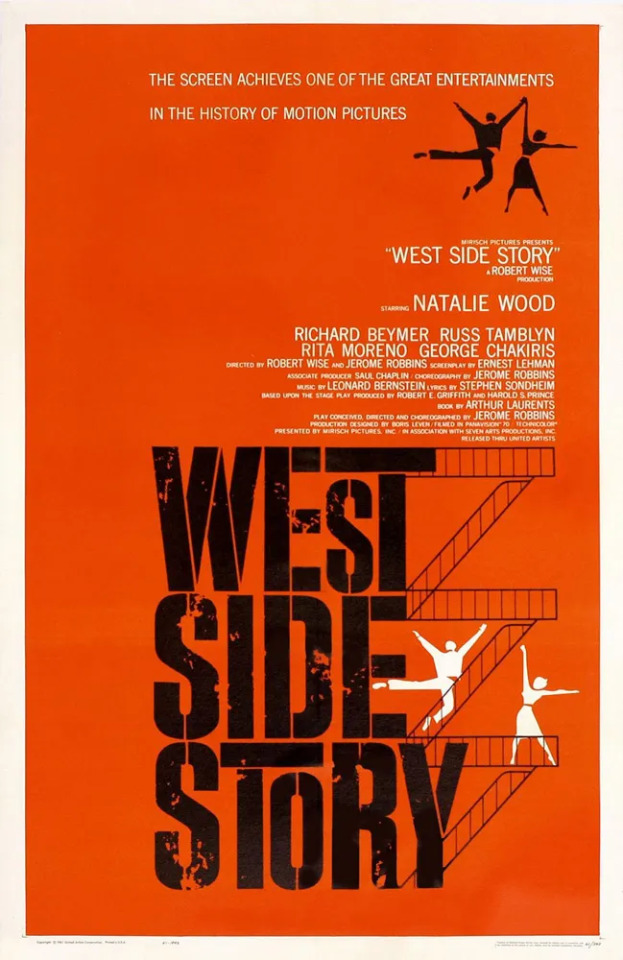

Finally I also really like Jessica Hische's work. It's really pretty to look at with their bold lettering and curvilinear lines that almost carry the letters out further onto the page, accentuating them. A lot of her work has a fairy tale, fantasy feeling to it that I love.
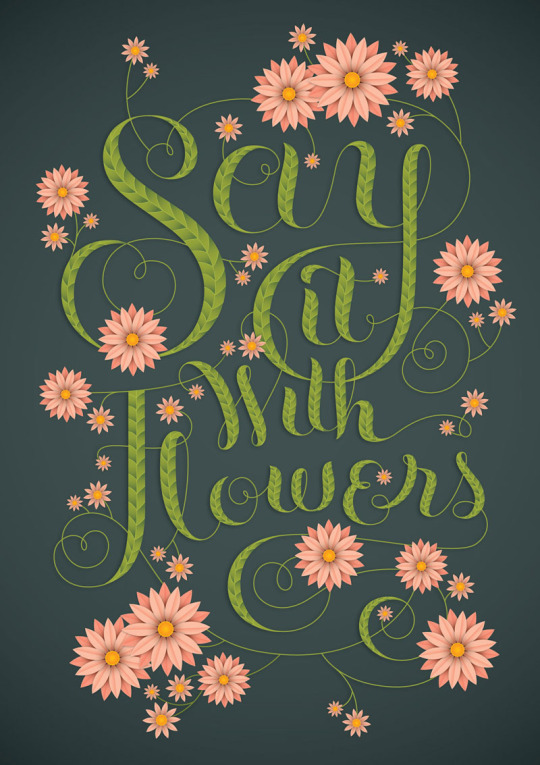
They then went on to show different methods of displaying text, whether it's in a 3D form, collage, textured or using unconventional materials or movement in photography using shutter shock.
1 note
·
View note
Note
hey, so i still havent read knifetrick yet, but i saw the post you reblogged about it being about capitalism's treatment of disabled people. im aware that this is just one interpretation of your work, but did you consciously make decisions about what messages to send within your story? did you purposefully include imagery or motifs or references or anything else to create a particular theme or idea?
im wondering because im making my own story, and im curious about what others put into theirs. i have a few key ideas i want to send with it, so i'm trying to tie all my characters and their arcs and the symbols and everything in my story to it. my brand of autism tends towards the "everything MUST have a logic to it!" and this is an obvious influence on it, but i still also think it's worth putting a lot of thought into it because theyre ideas i really care about. i want curious readers to be able to look into my story and see how it all ties together, and i want to impart messages of compassion onto my general audience as well. i think that all art has messages within it, whether personal or otherwise, and by being aware of what those are you can create a stronger and more cohesive story. at least thematically. if that is what someone wants to do, of course.
i know knifetrick is a story you started for fun. there is absolutely value in that (in your own joy) and i dont think art without intentional purposes or messages is inferior in any way. but did you ever get an idea for an overarching message in your mind, and implement it? its cool if you didnt, or if you did but dont want to say what it is too btw lol. im kinda just looking for the experience & thoughts another author had with their own thing. (i am very nervous sending this ask. i hope i dont sound like im jumping the gun.)
do not feel bad for asking this question, i'm always down to talk about my written works, even if it takes me a bit to collect my thoughts and figure out a response. yes, the truth is i went into knifetrick from the start with a lesson/moral i wanted to explore and teach. a fun fact about me is that i have several younger siblings, who are often being taught things i personally don't agree with. having conversations with them about what is really "right" or "moral" is awkward and not really doable. but stories and characters have always been a good and safe way for us to have this discussion-- why did this character do that thing, what makes this bad guy bad, and so on. this is why with writing i don't just like to tell a story, but i also like to teach a lesson. as patronizing as that sounds, i kind of just think it's pleasing when stories have a good moral behind them. although they don't need to for me to enjoy them. but back to the actual topic, yes. i did intentionally choose to explore the idea of capitalism's failure of certain groups of people in my story. that is what the main plot is actually wrapped around-- there's the obvious struggle with the main character, ran. he is physically and mentally disabled, he is treated differently than his peers. in a way he is fed from a young age the idea that the only way he can be considered equal to everyone else is to have a use to other people; to be the hardest working member of the order. his society encourages this worldview so that they can take advantage of him, but they don't actually care about him at all. they would discard him if he stopped being useful to them. the second example of this is the other main character, jackie. jackie's society also failed to take care of him-- he was orphaned, and then immediately lacked a support system of any kind, personal or governmental. he turned to a life of crime to make ends meet and repress his emotions, but all that did was eventually make his severe depression worse and manifest itself in a lot of anger issues and lashing out. by the time ran meets jackie, he's attempting to turn over a new leaf and take this opportunity he's been given to make an honest living; jackie cares a great deal about the people around him. the missing children are failed by society in the fact that they go missing in the first place, and nobody has bothered to try and find them (although the blame for that rests mainly on watson's shoulders, seeing as he tricked the king into thinking that was being solved). scoots and clem are failed by society as well- scoots is denied the job she actually wants to have due to her disability, and they are very poor. obviously this is made worse when clem goes missing, and since no one else is doing anything, scoots stops working to look for her sister. possibly the most obvious examples i can think of are maia snail and laggius maximus. maia's children are both autistic, with one of the two showing much more severe symptoms than the other. she's dealt with this in the way she best can as a mother, which is give them things they can comfortably work on to get their energy out and be helpful without having to do anything they don't like. society fails them as well, in that laggius is killed in the pit. but the more important part of their story is something snail tells ran: "i would have loved my brother even if he was never useful a day in his life, because he deserves it". essentially all throughout knifetrick, especially through ran, we are shown this idea of usefulness as equivalent to worth; i.e. how capitalism teaches us to view ourselves. we are shown how faulty of a system that is through the various characters. eventually ran realizes that he does not actually have to do anything useful to be worthy of existence, comfort, or love, and that is the sort of “end moral” of the narrative. ran ditches the council, showing that he knows his own worth and refuses to be tied to people who only ever hurt him, and then jackie helps the king start to reform subbin’s systems so that less people will fall through the cracks as he did.
so yes, that is essentially how i explored the idea of capitalism failing disabled people through knifetrick. there’s likely more stuff that i forgot but that’s what i remember off my head right now. anything anyone else sees in knifetrick about this topic is probably fair as well, death of the author and all that. this is what i intended while writing but other people might have seen more things in other characters that i didn’t think of too hard.
i hope that helps.
(bonus: firefox completely froze while i was at the end of this ask and made me fear for my fucking life. it took so much waiting and minimizing the program before i could safely save this to my drafts and then close firefox. terrifying.)
67 notes
·
View notes
Text
PÍA RAMBLES #6
nanowrimo is technically over and i barely made a dent on what was supposed to be my main wip during november. but one thought led to another and i made some changes that contradict the powerpoint i posted at the start of the month... so let me tell you about evergreen lung!
if you're new to my writing updates: because of how inconsistent i am with my progress i just label everything as a writing update and then theme them accordingly.
disclaimer: this is my original work, plagiarism of any kind won’t be tolerated.

[ all images ids in alt text! ]
i was having a lot of trouble making the relationships between characters work, which is a problem considering character relationships would make or break this book in particular. i've only written one and a half chapters which, i know is too soon to know if the dynamics were really as bleh as they seemed in my head (especially considering i've only barely introduced the character of raquel)... but things just weren't clicking in an appealing way.
so what did i do? i opened my phone's notes app and started typing naturally lmao. i laid out all my troubles and i think i've found it now! the version of evergreen lung i like.
these are the changes
august is now a completely different character! originally she was supposed to be ezra's "friendship interest" (like love interest but for friend) but i was having this problem about their relationship being too similar to that of ezra's mums xiomara and katalina. something that was bothering no one but if i didn't do something about it it was gonna bother me for all intended 70k words of this. i've aged august up and now she is running the radio station mentioned in the powerpoint (there's also something new and magical about her but [spoilers]).
it also allowed me to implement a dynamic i would have otherwise discarded with the changes i did to ezra's family, which makes me happy as i really liked it. see, since her inception august has been the someone new by hozier sorta character where she falls in love with pretty strangers on the bus. in the earlier versions of evergreen lung, ezra was supposed to live with her aunt who couldn't really hold down a partner and that was going to contrast with ezra who didn't want a partner. now that dynamic is the one shared between ezra and august! they have more of a "queer neurodivergent student who imprints on their cool teacher" vibe
juan diego figueroa! you may remember him as santiago figueroa from the powerpoint, i changed his name. the obligatory adam parrish-esque character because this is a book about a sentient forest. he's ezra's new platonic soulmate. a story about two aspec kids with lots of nature imagery surrounding them and whose relationship people are being extremely amatonormative about. after all, they're a boy and a girl so they should be falling in love
not only are they extremely cute, but their dynamic immediately puts me at ease with being Different(tm) from xiomara/katalina/caleb, which is what was bothering me if i had made a little trio out of ezra/august/santiago. as said in the powerpoint, his family runs the greenhouse where xiomara buys all her plant babies and it gives juan diego and ezra a fun thing going on. where they know each other but will grow to be each other's best friends much to their surprise
okay! let's talk chapters
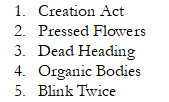
i have named a few scattered chapters. these are the first five (at least for now some titles could be moved around later). as of rn i have only written chapters one and i'm working on finishing chapter two. yes, in my head that is more than enough to talk

I: CREATION ACT
so for the uninitiated: evergreen lung is about this girl named ezra who died and then undied. what felt like passing out overnight in the forest for her turned out to be a year of her being missing.
i'd written the opening scene of the book many moons ago, around the time when i first had the idea for this story. it remains one of my favourite openers. here's an excerpt!
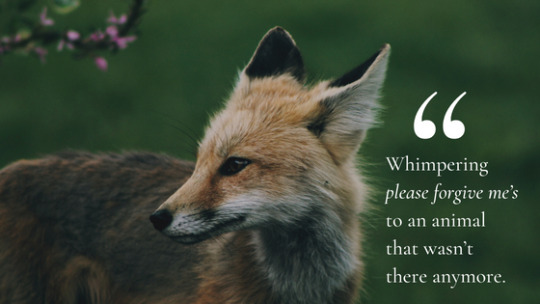
I woke up again because I couldn’t breathe. It turned into crying. Blood smeared on my cheeks, my nose, my mouth. I think… I might have been having nightmares, but I couldn’t remember. The sun made nightmares go away.
Checked my phone again, mechanical. The dead screen spiderwebbed and mosaicked with the honeycomb light through the canopy of branches. I did that three more times, forgetting each time, until I sprung panicked because the weight of my own body made my arm fall asleep and I thought the fox was back and had taken it along this time. I pressed the power button on the phone like that might will it to work.
I also got bitten on the leg, the tender tissue on the back of my knee, and I kicked. A fox with shamrocks as way of ear tufts whined and sprang away. That made me sit up and I cried, whimpering apologies. Whimpering please forgive me’s to an animal that wasn’t there anymore.
i'm now gonna shout out @rxinbowbright and @chaoticdecember because it's thanks to them that i even conceived making any progress with this book at all. and it's all thanks to the characters of ezra's parents who are actually our ocs for a personal project we share. with katalina being teddy's and caleb being fluffy's, xio is mine. it makes sense for a story about the importance of queerplatonic relationships for our main character to be born into one imo.
a while back (a long while back) i decided to start using chapter titles. they add so much personality and i think they need to do a comeback in books. i'm especially fond of the two words structure which is what i'm gonna be doing with evergreen lung. it creates such vivid imagery with something as simple as creation act, especially considering the subject matter. ezra coming back home and all.

II: PRESSED FLOWERS
aka ezra takes a walk around town and reunites with raquel, they go to a concert. alternatively: sometimes the main conflict is the fact your best friend has a boyfriend.
the plot truly begins here: ezra realises there's a disconnect between her and the person who's her best friend, she missed graduation and we all know how much things change in not even a year of being done with high school. the people you saw 5 days a week aren't part of your routine anymore, friend groups don't survive, everyone's got their own goals and no one's worried about the same homework as you.
other stories might turn raquel into the villain but there are no villains here (except for amatonormativity). i love raquel, and i love the relationship with her boyfriend like i love any other ship in my wips. they've got this fun garage band aesthetic going on and damian is friends with ezra... sadly while she was gone they planned and agreed to move out of town together. and now instead of having time to process this, ezra's arriving a month (or so) before it happens.
the title of pressed flowers is supposed to be a metaphor about preserving things.
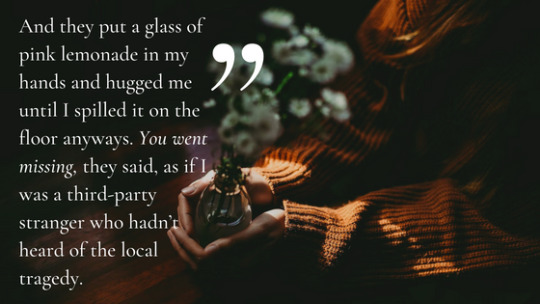
Raquel’s mum was a redhead like her two daughters. She was wearing an apron and a dress, hands clad with rubber gloves, she looked as if she’d stepped out of 50s USA nuclear family propaganda. Wendy was forced to stay outside and I stood in their kitchen on the verge of tears for an agonising ten minutes.
I kept asking them: Raquel? Raquel? Raquel?
And they put a glass of pink lemonade in my hands and hugged me until I spilled it on the floor anyways. You went missing, they said, as if I was a third-party stranger who hadn’t heard of the local tragedy. Instead of being the very subject of it. Yeah, I know, I said, objective, like speaking of the weather. Your parents— Raquel's mum started to say. They know, I said.
“She’s going to be so happy.” Marianela was holding the baby to her chest.
“Where’s Raquel?” I asked again.
“Not here,” her mum said. “She got this crazy idea in her head when she turned eighteen. Moved right out, said she was ready to be independent.”
“Where’s Raquel?” I asked again.
“She didn’t even have a job!” her mum said. “Now I think she’s working as a cashier.”
“Where’s Raquel?” I asked Marianela directly.
“The shopping centre downtown,” she said, patting the baby’s back as she became fuzzy. Warning of a wail. “They have these empty rooms serving no purpose at all.”
okay! i think that's gonna be it for now. i mainly wanted to talk about the changes i made (which also helps me it's the rubber duck method). and also hopefully this gave you a better idea of what the book's about, where it's headed.
the other chapters will tackle the following:
dead heading: the real weight of being gone
organic bodies: trying to reconnect
blink twice: ezra goes to a party with her old classmates
the sentient forest is coming, i promise.
cheers, pía
21 notes
·
View notes
Note
I mean. I knew Lily was ignorant and dumb but this hay’s code thing is another level. Alright gonna out myself, I’m a film major mostly in production and theory. Now the code was implemented in 1934 (though some say 1933). And it didn’t end (well there are debates as to whether we count the actual enforcement or the fact while the code existed but wasn’t enforced) until 1968. A 34-35 year not ten… 34-35 years of enforcement.
During that time there were directors who did sneaky things to fight back against the code. Have multiple kisses shorter than 3 seconds. Have suggestive imagery but blame the dirty thinking on the agent who saw the film to ensure the code was followed. And countless other examples. Not to mention the red scare also Played a BIG part of enforcement. The MPAA has done some things (like granting films with LGBT themes R ratings a rating with that excludes a lot of people) but it’s not as bad as the Hays Code who thought interracial love stories were a big no no, and in 1968 Star Trek had an interracial kiss that said F U to Jim Crow and Hays Code era thinking
my point was more going through the notion that even if it was "only 10" years that it was enforced, that's still a lot of movies, directors and creative people who saw all their hard work go to waste because it didn't meet some ridiculous criteria. for as many success stories you can count of people creatively managing to get around the hays code, there's as much if not way more stories of people and movies that never got made and no one saw. that's a tragedy, whether we're speaking 10 years, 5 years or the actual 30+ years that it was. a human being could have been born and die without ever seeing nothing else but hay's approved movies. it's a tragedy that something so simple and basic like a kiss between two people had to be revolutionary at all, it's disgusting that anyone ever said that two people shouldn't kiss because of racism. especially when we know that before that code existed, movies with queer people being queer already existed and they disappeared for 30+ years. some of them have been erased entirely. i don't understand how anyone can say that blaming the code hays or being mad about it is not only fair, but completely logical. it's not only deeply ignorant from her part to minimize the impact this had on cinema, but it's repugnant considering this is the same thing that LO always does: blame the individuals, never the institutions. the code hays was never implemented, but if it was then it wasn't a big deal and if it did it doesn't matter because these other movies came out, meaning that if your movie didn't it can only be your fault and not the people who enforced those absurd rules in the first place. it's not the fault of Disney that people are done with their "a person close to the production" always goes to the media to try to hype up movies around "our first ever gay character". it's the media, and the people who read that media, on the wrong because they just like to hate disney. it wasn't the fault of Disney's homophobia that TOH was cancelled, everyone just wants to hate Disney for no reason. it wasn't the fault of Netflix's tendencies of cutting queer shows short, the cancellation of First Kill was entirely because it was a "enemy to lovers" sapphic story. it wasn't the fault of Nickelodeon that the production of LOK was a mess, it was the writers and the people involved the only responsible because they should have known better, somehow. it wasn't the fault of Cartoon Network that SU went into hiatus more frequently than any other show at the time, no matter what the people who actually work for the company could say. it was the fault of Sugar for not magically knowing that a hiatus was coming and writing around it somehow. it's always the creative individual people who have the fault, not the companies who used them and disposes them whenever they please for whatever purpose. why do you think she doesn't speak about the big cut of HBO more? why do you think she isn't angry about how CN treated any other show that wasn't Teen Titans Go like utter trash? why is that when she wants to talk about WOW, she still talks far more about her white fantasy favourite female character being mistreated by a mere novelist writer than about the actual victims of harassment from the company?
because LO, for all her talk of being the only good leftist left, it's a capitalist anti-intellectual convenient tool whose true feelings will always have more in common with conservatives that she'd like to admit it.
13 notes
·
View notes
Note
🛒✨🎶💌 ! and, are there any elements that you’d like to incorporate into your fics and writing that you haven’t yet (for reasons of time/opportunity)?
Omg sorry I am just answering this now. I didn't think I'd get any asks... And sorry this got Very Long. I'm an incredibly self-obsessed person who loves Being Asked Things About Myself.
Fanfic Writer Emoji Ask
🛒 What are some common things you incorporate in your fics? Themes, feels, scenes, imagery, etc.
Oh hm, let's break this into parts.
Themes:
Grief/longing, haunting as part of that, difficult family relationships, love but not in the way it matters
Feels
Somberness, intimacy, despair, fear
Scenes
Quiet moments between characters where they don't say anything, but let the silence speak for them as they try to understand one another. <- not great at writing dialogue
Cooking: someone cooking for another person or someone eating someone else's cooking, shopping for cooking materials. etc.
Someone looking out the window or something similar
Imagery
I'm actually not sure about this one, I guess I make a lot of references to the night and the sea, and also like blood and guts. I think it's stuff with internal organs after all? Or maybe I just like the imagery of things coming apart. Usually they involve the body in some way. Escape or wistfulness or fear and danger are usually portrayed through the waves or the night atmosphere. Or something. Sorry, I'm not a lit major so I can't really. word it much better than this. I am also lost. If anyone's ever read a number of my works, maybe they can tell me lol.
✨ Give you and your writing a compliment. Go on now. You know you deserve it. 😉
Ughhh this is so hard because I'm a very harsh critic on myself, but I guess it's cool that I'm like, trying hard or whatever. I may not write as much this days, but the few odd pieces of poetry and such do come out okay-ish even if they also look like something that can be written much better by like, 14 year olds or something and are also super angsty with no substance. It's like, cool that I can somewhat implement some stuff I've learned be it through theory books (which I've not finished.) or through assimilation from reading other works. Like woo I'm not super horrible at studying, or whatever. I've also been told my writing is pretty "evocative" and "emotive" so I guess it's probably true? I do write a lot of my feelings. And I actually do like how... filler-y all my works feel, how meandering they are. I know nothing about film, but I always think of my writing in terms of like, directing, as in how do I want these scenes to play out? And I know not a lot of people like this sort of writing style, but I do...... Maybe I won't write anything of substance or whatever, but I can write pretty things to please myself or something.
🎶 Do you listen to music while you write? What song have you been playing on loop lately?
Not really. I have something wrong with me so I can't really listen to most music when trying to write, because I'm easily influenced by the words being sung or I'd get distracted by the melody. I think I only listen to like, classical arrangements or white noise whenever I try to write. Because otherwise, my brain would be thinking of the lyrics instead of what I'm trying to write. It's the same thing with like, people speaking around me. When I can't fully tune it out, I end up... being too focused on the conversations around me and not on my actual writing lol.
As for what I've been playing on loop.... I'm told it's I'm Not Okay (I Promise) by MCR LMAO.
💌 How do you feel about comments and feedback?
I love comments and feedback!! I always get so amazed whenever I get them because it's like, wow, you people actually care enough about my work to read it and show me what I can do to improve it??? It always feels surreal to me, I always go back to my comments section whenever I feel like shit to make myself feel better. Even the simplest comments make me happy... I get excited just by knowing people out there are seeing the stuff I put out...
But well, of course I'm also a bit wary sometimes when it comes to getting beta'd because I'm bad at not taking concrit personally and also because I constantly feel the need to be shaped by every input, like I have to follow everything to the letter, but I'm... slowly working on that lol..
Are there any elements that you’d like to incorporate into your fics and writing that you haven’t yet (for reasons of time/opportunity)?
Oh there are so, so many things I want to incorporate into my fics and writing, but I feel so, so terribly inadequate in both my skill level and my time to execute them properly:
childcare/childrearing
genuine, solid horror
sweet romance that's genuine and not one-sided or boring. And also good steamy scenes. I'm bad at these because I'm chronically bitchless and also evil and bitter and have issues.
comedy
more solid worldbuilding
better dialogue
more intricate prose
EFFICIENCY!!! I want to be able to be concise while still conveying a lot....
Sorry if I'm not getting this question right, btw fskdjfdsf
ANYWAY. THANK U SO MUCH FOR THE ASK ANON <3
4 notes
·
View notes
Photo
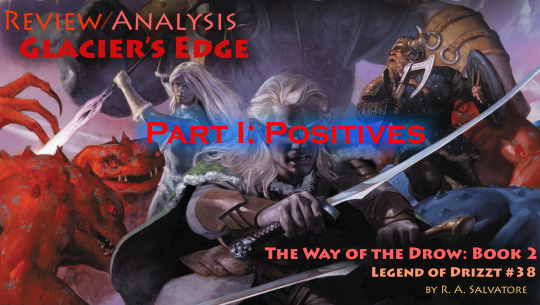
[[ This post contains Part 1 of my review/analysis of the Forgotten Realms/Drizzt novel, Glacier’s Edge, by R. A. Salvatore. As such, the entirety of this post’s content is OOC. ]]
Genre: Fantasy
Series: The Way of the Drow: Book 2 | Legend of Drizzt #38 (#35 if not counting The Sellswords)
Publisher: Harper Collins (August 09, 2022)
My Rating: 2 out of 5 stars
Additional Information: Artwork for the cover of Glacier’s Edge and used above is originally done by David Palumbo. This post CONTAINS SPOILERS. Furthermore, this discussion concerns topics that I am very passionate about, and as such, at times I do use strong language. Read and expand the cut at your own discretion.
As of this point, I am still finishing this document. I will be posting the subsequent sections. The table of contents will be updated when it is complete.
Contents:
Introduction
I. Positives (you are here) I.1 Sublime Similes and Marvelous Metaphors I.2 Other Effective Imagery I.3 Consistent Lore and Decent Worldbuilding I.4 Respectable and Respectful Characterization
II. Neutrals
III. Negatives (Technical Writing)
IV. Negatives (Characterization)
V. World Breaks
VI. Religious Commentary
VII. Ego Stroking
VIII. Problematic Themes
IX. What’s Next
Positives
Overall, the technical aspect of the writing in Glacier’s Edge is better than a lot of Salvatore’s work. It shows a noticeable reduction in what I’ve dubbed "Salvatorisms", which are negative writing quirks belonging to this author that repeat entirely too frequently. His favorite adjectives “fine” and “magnificent” are used in moderation. There aren’t as many two word sentences. He doesn’t abuse the “how [character] did this [action]!” construction as much as he does in other books, hopefully this means that he’s finally realized that stating "how" something performs an action, such as, "how clumsy and slow it appeared" and "how unusual it was to see both of his eyes", still doesn't actually convey much of anything no matter how often he uses it. The combat scenes are better described, featuring fewer scenarios reminiscent of stop-motion screens from Hollywood C-list movies and not well thought-out details that try to pass as masterful combat maneuvers.
Sublime Similes and Marvelous Metaphors
There are decent if not solid examples of writing in Glacier’s Edge. Salvatore does employ some good analogies and turns of phrase. This section discusses the effective similes and metaphors that can be found within the book.
Metaphors are often good implements in writing because they show rather than tell, but what makes a good metaphor is not only the ability to be illustrative. To be properly evocative, a metaphor also needs to convey a mood that is appropriate to the situation. One such successful metaphor is, “the priestess Minolin Fey Baenre wore the look of a displacer beast after cornering a giant rat”. In this scene, Minolin Fey, a lesser female, is gaining an advantage over Sos’Umptu Baenre, who is both a priestess of Lolth in high favor as well as being a member of Menzoberranzan's ruling council. The metaphor properly conveys the balance of power in this scenario. In addition, like drow, displacer beasts are denizens of the dark, graceful and deadly yet possessing an inexplicably magnetic and exotic beauty. Finally, Minolin Fey is scoring quite the big one against Sos’Umptu, and the reader can feel her degree of satisfaction as a hungry predator would upon finding a sumptuous meal. It can even be stated that the employment of “rat” in this metaphor takes it one step further, as the saying, “I smell a rat”, means detecting that not everything is as it appears, which is especially appropriate in this case, as Sos’Umptu is bringing typical Lolthite intrigue and misdirection to the table.
Similes, on the other hand, are often thought to be easier to use than metaphors due to the direct employment of words that indicate that a simile is present, such as “like”. However, in reality, too many people rely on the “like” to do the work for them, not being careful to ensure that the comparison works on its own merit. Salvatore is definitely guilty of that reliance, but one simile in Glacier’s Edge that is successful is, “The eight hundred fighters of the Blaspheme hit the left flank of the attacking drow force in waves, like sheets of rain blown on furious winds.” Despite Salvatore going on to detail the battle, none of the descriptions that follow convey the situation as well as that one sentence does. Be it walking, riding a bike, or driving, anyone who has encountered rain that’s falling so hard that it can be described as sheets instantly remembers the intensity of the phenomenon. It immediately brings to mind the sense of helplessness and dismay as such a downpour thoroughly drenches a person, totally obstructs their view, and/or instantly renders the road dangerous terrain. Just by itself, “sheets of rain” already convey that the opposing force is routed, but the addition of “on furious winds” further illustrates how little of a chance they had from the very beginning. Even a bit of rain with heavy winds can be pretty intimidating weather, but with heavy rain, high winds can make it appear as though the rain were going horizontally. I’ve not personally seen sheets of rain combined with the type of wind that makes rain go horizontally, but it is a frightful phenomenon to imagine. In this battle, the Blaspheme are, to use a cliché, cutting through the Lolthite army like a hot knife through butter. While that cliché is technically also a simile, it would have been a writing fail due to its overuse. Good on Salvatore for not employing a cliché in this scenario.
In the same vein as the previous, “for the Blaspheme whirlwind was spinning out beyond him, driving their enemies like a panicked herd of rothé” is another effective simile, or more accurately, a metaphor and a simile. This imagery calls to mind an almost comical Wizard of Oz-esque scene in which a tornado rips through an idyllic farm backdrop, with panicked cows running every which way. It’s a fitting image indeed, for, as discussed above, those who oppose the Blaspheme have little chance. The analogy is also charming in the employment of the mention of rothé, which are the cattle that the Underdark societies cultivate. As with the displacer beast comparison, it hits an additional sweet spot by citing a creature that is both familiar to the reader and appropriate to the setting.
The aforementioned charm is also present in, “The webs are hers alone to pluck, like the strings of an abyssal lute, to make the song she determines.” The character being mentioned here is none other than the Spider Queen, Lolth. Everything about this metaphor and simile fits so well. The webs can refer to the literal webs in Lolth’s domain, the Demonweb Pits, the metaphorical “webs” of intrigue that define her people’s societies, the web-like layout of Menzoberranzan, and really, anything and everything about the drow who worship her. It harkens to the Demon Weave and even the web of blasphemy that Quenthel and Yvonnel wove on the surface, although Salvatore likely didn’t intend it quite so thoroughly. Nonetheless, whatever those silky strands may refer to, Lolth, plucking them, could be a puppetmaster directly pulling the strings attached to the drow, or a maestro playing the tune to which they dance. Furthermore, the lute is a setting-appropriate instrument, an abyssal version of which feels like it would especially suit a dark goddess. There’s a sense of delicateness in this imagery, with a lurking hint of threat, as one would expect if imagining the once beautiful elven goddess Araushnee plucking the strings with her graceful and delicate hands, except the whole is twisted and warped by darkness, she into the form of a grotesque giant spider, and her tune into the haunting chords of the Underdark.
Another effective simile is the one contained in, “Eskavidne paused and sighed, a truly grumbling sound in her melted-candle form, like an underwater burp from a hill giant.” Although no reader has witnessed any kind of emissions from a hill giant and perhaps not many have witnessed underwater burps from any creature, all would know what a burp sounds like. It’s then easy to imagine the gurgling quality added by the underwater aspect, as well as a definitive moistness to the sound. Both that gurgling and moistness befit a creature that resembles a lump of melted wax, but the association with the hill giant, in addition to reminding us that these handmaidens are very monstrous and unnatural beings, possesses that charm of fitting in with the setting. The first part of the sentence is actually pretty bad, with the nondescript adjective “truly grumbling”, which might be one of the worst examples of telling instead of showing. Although it would have benefited from not having the first part at all (or just the simple drop of the “truly” part), the sentence is saved by the effective simile.
In this sentence, “He went right past Savahn, whose open hands were drumming the life out of the other gnoll, every strike just ahead of its attempted block, or just behind, just far enough so that the blocking arm had moved up too high.”, an effective simile once again saves the day. The comparison of the attacks of an unarmed martial arts master to playing an instrument that defines the rhythm of an entire performing ensemble is rather poetic. When we think of drumming, we think of sounds that reverberate through the listener’s body, but unlike bursts of a firework, they are balanced and measured. There’s even a reciprocity in this simile, with our knowledge of Savahn being at the top of her order feeding into an assumption that the drumming would be that of an accomplished percussionist rather than a novice one. We can feel how that “performance” is so resounding that it makes one want to clap one’s hands over one’s ears, yet at the same time the cadence is so compelling that the listener, much like the gnoll, is entirely trapped within the musician’s thrall. Without this simile, the sentence would just be a stiff, stop-action description with none of the imagery and the flow.
Another effective simile is in the sentence, “Galathae went up to her knees, then fell to a sitting position, legs gripping the crystal beam as if she were riding a fat horse.” While technically, a fat horse would neither appreciate nor tolerate having a rider grip it in that fashion, nor would a rider want to do so, this simile conveys the intended image perfectly. Perhaps it might be aided in probability by specifying an “unsaddled fat horse”, but it’s fine on its own due to how evocative it is. With just eight words, the simile conveys that the crystal beam is very thick, that Galathae has to spread her legs wide, and that it’s not a comfortable “ride”, all without carrying any of the inappropriateness that my explanation does.
Other Effective Imagery
The passages discussed in this section show that Salvatore can write evocatively without the usage of similes or metaphors. The sentence, “‘Hehehe,’ the green-bearded dwarf said, nodding so hard that his lips flapped through the response.”, is one such example. Salvatore didn’t even need to include the words, “so hard”, for someone would have to have unreasonably disproportionate lips to have them be able to flap with normal nodding. Even so, most people and creatures wouldn’t be able to flap their lips even if they were to nod hard enough such that their heads detached from their necks under the strain, so this descriptor does a good job of calling to mind Ivan’s appearance: that he is a member of a fictional race of humanoids with significantly more pronounced facial features than we have, that he’s elderly and that his skin has loosened significantly with age, and that he’s a comical character. Using descriptors that allow the reader to see rather than be told what’s going on can have the excellent side effect of also conveying things beyond what is seen, such as personalities.
The sentence, “He managed to put the dark thoughts aside as the day wore on, as the world rolled out beneath him, but when they landed that second day, it all chased Drizzt back down to the earth.”, contains a good turn of phrase, namely the final part. The sentence actually starts out pretty awkward, the repeat of the words, “as the”, almost makes it feel run on, and it would benefit with the replacement of the second “as the” with “and”. However, the last phrase ties the whole together well, emphasizing how Drizzt was figuratively and literally flying high, then figuratively and literally grounded and low.. The parallel between the literal and the figurative up and down feels neat and complete.
Allefaero, a new aevendrow character introduced in Glacier’s Edge, is one of the few instances in the book of showing rather than telling. We get to know him best of all in the following passage:
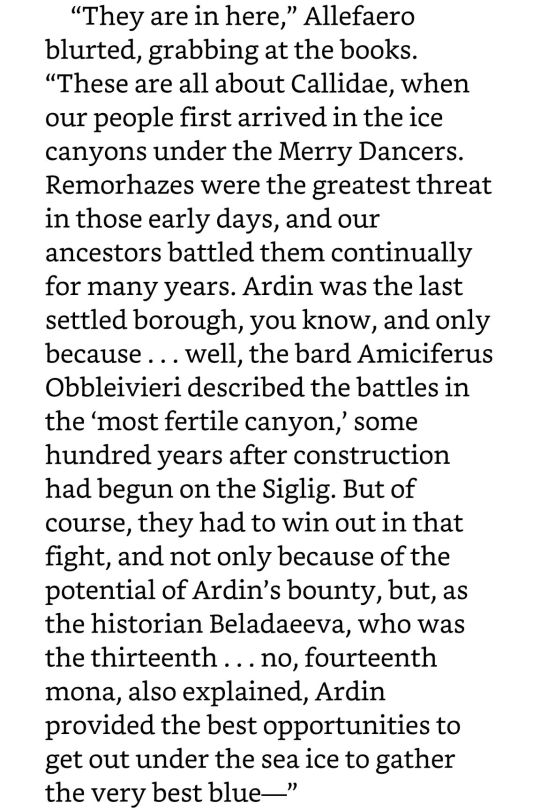

In this page and a half on a smartphone Kindle app, we learn about a bunch of disjointed Callidae history. Allefaero’s rambling, complete with cataloging the details of the personnel involved down to the phrases that they coined, paint a better picture of a gawky young wizard perfectly befitting the nerd stereotype more so than any of the passages describing him before does. Even though every aspect of this recounting is almost certain to never come up again, it is a more worthwhile expenditure of pages than pretty much all of Salvatore’s combat scenes because it conveys the essence of the character well despite none of the words being about him personally.
Another solid piece of imagery is found in the following: “It flashed up at Ygorl, striking the smoky slaad, which made Ygoril itself look like a thundercloud, the arcs of lightning flickering about the ribs and bones within the dark cloud of the being.” At first glance, this might seem like a metaphor, but it actually isn’t, for Ygorl the slaad god (in Salvatore’s presentation anyway) has a body that’s literally dark fog/smoke, making it rather cloud-like. Taking advantage of that aspect to illustrate how a lightning attack would affect the creature is poignant.
This section and the previous one contain examples demonstrating that Salvatore can write decently. Why he ends up not doing so for the most part, be it by choice or otherwise, is anyone’s guess.
Consistent Lore and Decent Worldbuilding
Although outnumbered by the times that he breaks or changes existing lore, sometimes Salvatore does hold true to it, which is always really nice to see.
One of the things that I really appreciate that Salvatore doesn’t neglect is the specification of the relative sizes between male and female drow. As an author who tends towards socio-normalization within Western cultural standards, I find it both astonishing and pleasing that he doesn’t forget that canonically, female drow are larger than male drow. No matter how many times he mentions it, I’ll always compliment him for doing so, as he does in Glacier’s Edge:

There isn’t any precedence for the other revelations in this passage. Although established drow history states that there have been female warriors, none of the sourcebooks say anything about any period of time in which female drow being the best warriors or dominating the warrior rank. However, it wouldn’t be terribly unreasonable for that to be the case in a species in which the female members are larger and stronger than the male members. Furthermore, as this is a recounting by a character, like any verbally-delivered message it could be subject to exaggeration or an inaccurate memory. In this particular case, the character speaking is someone who’d spent millennia in the Demonweb Pits as a drider, and while she seems sound of mind, it wouldn’t at all be unreasonable to apply the unreliable narrator explanation to her. Assuming that female drow dominated the warrior role in the past, it also wouldn’t be unreasonable for fighting styles to change if that role became overtaken by a section of the population that is not only smaller, but also possessing different muscular development. Assuming that drow are like us, male drow would have more developed upper body muscles while female drow would have more developed lower body muscles. Of course, Salvatore doesn’t specify how the fighting styles changed, but perhaps the female-dominated style involved more lower body action or even totally different weapons, while the male-dominated style focused almost exclusively on the weapons wielded in hands. This is just a wild speculation however, as it isn’t a totally safe assumption because we haven’t been told either way and a fantasy race doesn’t necessarily have to have their sexes differentiated in the same way, or, in fact, in any way. Nonetheless, the premise put forth by Salvatore here isn’t wholly impossible.
Another creature that Salvatore portrays well in Glacier’s Edge is the illithid adviser to the drow, Methil El-Viddenvelp. Amidst the unfolding civil war brewing in Menzoberranzan, it approaches Yvonnel to make the observation, “Courage is often found in anger among the lesser beings.” We then receive a reminder about the nature of the alien mind flayers with Yvonnel’s musings:

This is a good thing to note because the illithids have always been a master race of creatures possessing supreme intellect, so much so that canonically, the least intelligent among all illithids is still smarter than the most intelligent human (and implicitly, drow). Furthermore, to the illithid, whose diet is the brains of other sentient humanoids, Yvonnel is the equivalent of a delicious meal. To an illithid, describing a drow as a “lesser being” isn’t making a slight, it’s simply stating a fact. This is good characterization because it stays true to established lore while also helping put us into Yvonnel’s mindspace, as well as reminding us that she’s a proud female and a proud drow.
All that being said, there is a problem with the above passage, namely, the use of masculine pronouns for Methil. Illithids do not possess gender or sex. When they undergo ceremorphosis, the process by which a tadpole (their progeny) matures, the host’s identity, along with their sexual characteristics, are scrubbed away to produce a creature that doesn’t possess a whole lot of differentiation from others of its species. It could be argued that the “they/them” pronouns would suit illithids better than the rather dehumanizing “it”, but illithids are very much not human, and the “it” pronoun serves as a poignant reminder of just how much that is the case.
It does happen that occasionally, the ceremorphosis is incomplete or imperfect, and the resulting illithid retains some sense of identity of its host. In these cases, the illithids in question might subscribe to gendered pronouns or even names of the hosts. However, this has never been indicated to be true of Methil, so attributing masculine pronouns to it is rather odd.
Consistency is not Salvatore’s strong point, even with his own lore, but it is present in the passage, “The Hunzrins were to the other houses, certainly to Mez'Barris Armgo, as Jarlaxle's mercenary band was to House Baenre, serving as merchants beyond the confines of Menzoberranzan." This function of the Hunzrins is not present in established Realms canon beyond Salvatore’s pages. Within those pages though the Hunzrins have always been one of the major food suppliers to Menzoberranzan via their responsibility of tending the rothé herds. In fact, the current matron mother of the Hunzrins, Shakti, has always been more passionate about seeing to the rothé than she is about fulfilling the conventional Lolthite female role. Under her care, the rothé numbers flourished, and it was primarily due to her efforts that the herd was able to recover following its depletion from the secondary effects of Yvonnel the Eternal’s march against Mithril Hall. During the events of the Homecoming Trilogy, House Hunzrin is revealed to engage in trade with other races of the Underdark, even rumored to trade with surface cities. This was significant because of Bregan D’aerthe’s loyalties being suspect, with non-Baenre factions utilizing the Hunzrins to get their fix of whatever it was that Jarlaxle’s crew provided with them before. Now, once again, with the factions split, it makes sense that the Hunzrins’ trade routes would be heavily leaned upon. Salvatore did well in preserving this factoid, in his normal fashion he could’ve suddenly pulled out an unheard of before minor house that’s been doing trade with other cities all this time. Such would be very unlikely, given both the extremely xenophobic nature of Menzoberranzan and the perils of the Underdark.
Another aspect that makes the aforementioned passage good is that it doesn’t butt heads with established lore. An important aspect of the Baenres’ strategy in the civil war is controlling the food supply, and they do so by sending their soldiers to occupy Donigarten and capture the rothé herds. In doing so, they kill two birds with one stone: directly preventing their enemies from getting food, and also keeping an eye on the Hunzrins, who, as Glacier’s Edge maintains, are stewards of the rothé. There might be some liberties taken with where the Hunzrins’ base actually is, all established canon mentions is that they’re situated in Eastmyr, a district that’s primarily home to commoners like mercenaries and lesser merchants. Eastmyr is a large area, and is immediately adjacent to the Lake Donigarten. Given that the Hunzrins maintain the rothé, it would make sense that their house complex would be close to the lake if not immediately on the island, thus making it reasonable for the Baenre troops to have occupied their premises when they captured Donigarten.
That said, although good, it is more than a bit strange that Salvatore decided to play nice with this bit of shared lore. Much of the Hunzrin history is fleshed out by Elaine Cunningham in her Starlight and Shadows trilogy, Salvatore has demonstrated a history of suppressing everything about the contents of that trilogy, ranging from the blatant erasure of Eilistraee to the underhanded subterfuge of making another wizardly daughter of Gromph and giving Drizzt a female child so that when many hear the phrase, “daughter of the drow', they would think of Brie-Zara instead of Liriel Baenre. Even the title of Starlight Enclave seeks to reassign the existent association of sanctuaries under the moon and stars, which is attributed to Eilistraee, to the ridiculously utopic Callidae. Of course, I might be thinking too much into it, but Salvatore could have chosen Yvonnel to literally be the daughter of anyone, and for Drizzt’s child’s gender to be literally anything, yet he settles on the two options that have the highest chances of overriding Liriel’s identity and tale. Similarly, there are lots of stars above Callidae, and it’s a safe place in the cold, so maybe that’s just a coincidence too. However, given that he also has a demonstrated history of being petty and insecure when it comes to other Realms creators, I don’t think it’s a mere coincidence.
That being said, the Hunzrin lore as laid out in Starlight and Shadows is reinforced in the War of the Spider Queen series, a series that, although Salvatore did not have any part in writing, he did oversee. However, simply overseeing it hasn’t restrained him from stomping all over its contents. The WotSQ series doesn’t really do Eilistraee any favors, but compared to what Salvatore does to her in the Drizzt books, the WotSQ might as well be putting Eilistraee on a pedestal.
However, Salvatore doesn’t take this erasure tack with the Hunzrins in Glacier’s Edge. Even more impressively, he directly alludes to events in Starlight and Shadows with regards to Shakti Hunzrin:

If my hypothesis is correct, this refers to the time that Shaki was both a priestess of Lolth and of Vhaeraun, the latter of which wasn’t known to others in Menzoberranzan. Shakti was so obsessed with capturing her rival Liriel that she embraced the additional powers granted by Vhaeraun even knowing the heresy against Lolth in doing so. However, as of the current timeline, this is in the distant past. It’s the kind of detail that Salvatore could’ve gotten away with not mentioning, which would’ve left those who have read the Starlight and Shadows trilogy going, “Oh did you know Shakti was a priestess of Vhaeraun?”, with no real consequence. Honestly, it’s just terrific that he mentions this history. It makes the intrigue more interesting, and referencing a shared world’s history makes the entire story richer and more interesting, while making the world feel more alive and vibrant. In addition it's nice to see RAS giving a nod to his fellow creators whose collective work made the world so beautiful.
Detailed worldbuilding has never been Salvatore’s strong suit, even when it comes to Menzoberranzan and its drow, despite all of his touting of, “I'm the creator of the Forgotten Realms drow”. Thus, it is great to see details like:

It has always made very little sense that inter-house wars in Menzoberranzan persisted beyond the first exchange of hand crossbow volleys. Of course, we were just left to assume that either the above passage was the case, or that the drow are collectively worse shots than Stormtroopers. Both were equally possible in Salvatore’s worldbuilding, so it’s really great that he specifies, especially as it would not only make good sense for it to be the case but also quite stupid if it weren’t.
There are lore factoids that check out even moving away from the drow. Remorhazes, also known as polar worms, play a big role in the events of the arctic north, and a lot of liberties are taken with their lore, except for this one:

The specific size of remorhazes is not specified in fifth edition D&D, which only gives a size category for the young and adult variants. Their size was specified in first edition however, specifically that adult ones fall between 21 feet and 42 feet in length. “More than thirty feet” falls pretty much exactly in the middle of that range of average lengths, making one wonder if Salvatore consulted the older material or even the Forgotten Realms Wiki for that information. Kudos to him if he did, that would indicate concern for the material and the lore. That would be a great thing indeed, as it’s no coincidence that his writing was significantly better when his concern for the lore was more present.
Salvatore does do something he’s never done before in the Drizzt books, and he does this amazing thing not once, but twice. One of the things I rag on him about the hardest is his artificial enforcement of the lack of resurrection spells in a magic-rich world in which various methods of resurrection not only exist, but are relatively plentiful. Most classes capable of healing have some form of bringing someone back from the dead, and the commonplace nature of this mechanic is something that other authors have successfully incorporated into their novels. However, much of Drizzt’s angst and the tensions of Salvatore’s plot revolves around death and not being able to do anything about it. This trope is repeated so much in the Drizzt books that the proverbial elephant in the room is tarrasque-sized.
Thus, when in Glacier’s Edge resurrection mechanics are used, the sensation is like staring at a black and white landscape, blinking and beholding a world suddenly exploding with color. The first time that the book acknowledges resurrection is with regard to the druidic version, reincarnate:
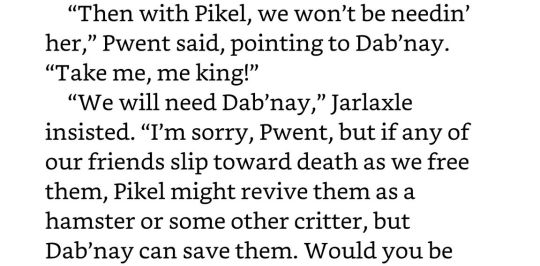
Although I’d relish an alternate universe in which Pwent got his way and events play out such that Drizzt and the CotH get reincarnated as slugs, I’m content for now that the existence of reincarnate is acknowledged. What Salvatore has written is also literally and exactly what reincarnate does: it brings the creature back to life, but in a random body. Salvatore FINALLY acknowledges that resurrection exists, and does so in the proper context of it being neither a big deal nor rare (at least, not to individuals who are supposed to be very powerful and resourceful as are the ones in his books). He even has the details of the spell mechanics to boot. Not going to lie, I was positively giddy about all of those things.
But that’s not all. The above passage only talks about resurrection, which would’ve been great enough and a breakthrough for Salvatore on its own, but later he has Dab’nay actually bringing someone back from the dead, and not just some no name tertiary character never to be mentioned again:
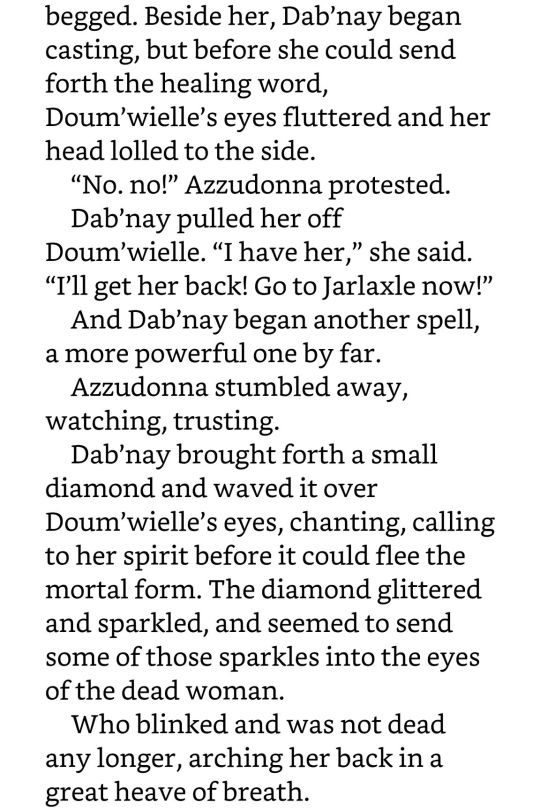
I’m still stunned. I can’t believe Salvatore actually wrote this. He doesn’t just imply that Doum’wielle died. There’s none of his usual handwaving maybe-this-happened-but-I’m-going-to-be-noncommittal about-it going on. He actually states that Doum’wielle was really dead, making it clear, without a doubt, the nature of the spell that Dab’nay uses, and by association, that it does exist in this world. He even gets the mechanics of the spell correct, namely the requirement for verbal, somatic and material components, the latter of which is the diamond. Given the description of the diamond as “small”, I would guess that it is the 300g variety, the smallest of diamond components in cleric resurrection spells. The spell would be revivify, which also fits in this case as Doum’wielle literally just died, and revivify only works on the target if it passed away within a minute. Being dead for longer wouldn’t be impossible to handle, it would just require more powerful spells and more expensive diamonds. I am extremely curious to see if Salvatore will continue to acknowledge and include the existence of resurrection spells in his future books. Not imposing artificial restrictions on common aspects of a world makes for so much better writing.
Respectable and Respectful Characterization
For the most part, characterization in Glacier’s Edge is sparse, leaving the reader feeling as though they’re watching different names drift across the pages rather than people enacting their roles. However, there are some exceptions to this pattern.
First, we finally see some age-appropriate behavior for Yvonnel the Second. Despite her magically-induced appearance as an adult drow female, she is actually only six years old. We’ve been told that her psyche matches her physical appearance due to being infused with Yvonnel the Eternal’s memories in the womb. However, much like how memory is (mis)handled in these books, which will be discussed more in a later section, memory doesn’t equate knowledge or character.
In Glacier’s Edge, Yvonnel 2.0 comes face to face with a very personal matter that hasn’t had a precedence in Lolthite drow culture for quite some time: the existence of maternal love. In the past, Yvonnel 2.0 treated Minolin Fey, her birth mother, with contempt and dismissal. Now, faced with the task of reforming Menzoberranzan, she realizes that she needs to start with changing how she herself behaves. However, she is woefully unprepared for this, and despite throwing herself into the task wholeheartedly, it is one of the very few times that we see Yvonnel 2.0 struggle to accomplish something:

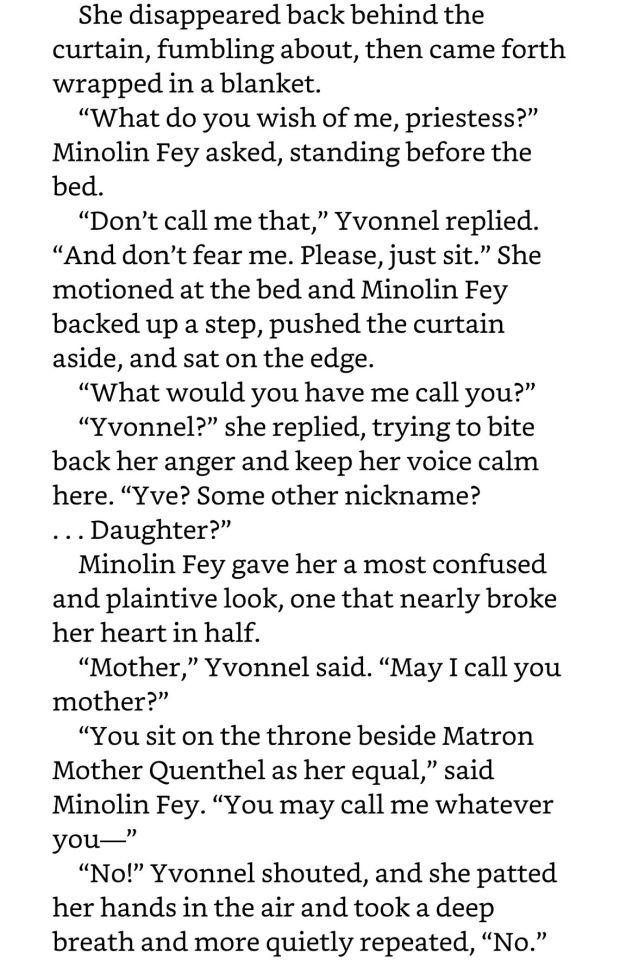
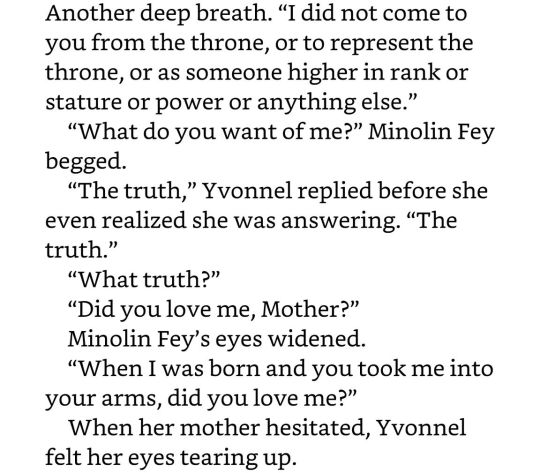
This confrontation is one of the few character portrayals in the entire book that rings true. Yvonnel throwing a tantrum against the door is so reminiscent of teenager angst, and so out of the norm for the normally extremely competent and composed priestess. What's more striking about this scene is how actively afraid of her Minolin Fey is, and how easy it is to imagine how that fear is amplified by Yvonnel asking something so wholly foreign to her. What makes it poignant is that Yvonnel wants Minolin Fey to immediately slip into habits that come naturally to her allies from the surface world, whose entire experience is so far from Minolin Fey's that the poor drow woman would've been less afraid were she facing an angry Yochlol instead. What's more, through what's fundamentally a clash of cultures between mother and daughter, it's the first time in a long while that a Drizzt book has stirred my emotions, for this scene calls to mind the many many struggles I experienced and witnessed growing up bicultural in the United States. Such a chasm need not be based in ethnicity either, cultural gaps between different generations can lead to the same type of occurrence. This rift, this invisible distance, the sense of incredible yearning on one side met with total confusion and inability to fulfill that deep desire on the other side, is what gives rise to modern tropes like the millennial parental apology fantasy. Fortunately for Yvonnel 2.0, she does eventually find what she seeks, in an implausible way that’s becoming a trademark for Salvatore, but nonetheless, for a little while, we bear witness to some rare and touching character development.
Gratuitous sex scenes, especially among the drow, has in the past been one of the themes that Salvatore would use quite frequently. Thankfully, he hasn’t done much of this in the more recent books, although it is somewhat strange that he has not included much sex at all. Thus, it was concerning when happening upon the sex scene between Dinin(ae) and another former drider, Aleandra. However, startlingly, this scene actually serves a purpose, and is rather tender and heartwarming to boot. Dinin and Aleandra are camping out in their battle stations, and during their turn on break, they begin to discuss life before becoming a drider, reflecting on all the things that their humanoid bodies could do that their drider bodies could not. This then leads to a spicier topic, and Aleandra propositions Dinin. Dinin initially turns her down, in large part because he’s reminded of his previous life in which females did not ask but commanded. To his great surprise, Aleandra, though hurt, backs off immediately and respects his wishes. Aleandra does so because she is from an era in which the Lolthite matriarchy did not exist, but nonetheless, this is an excellent portrayal of how important consent is, and is perhaps more convincing than any of the exposé about the aevendrow. In respecting his choice, his autonomy, Aleandra treats Dinin as a respected equal, and such treatment is the basis of goodness. The fact that Dinin ultimately accepts Aleandra and is the one to initiate the intimacy all while they themselves at the very heart of Lolthite society is more of a spit in the Spider Queen’s eye than all the bashing that Salvatore includes later.
Glacier’s Edge also does a good job of noting varying mindsets of former driders, who are now known as the Blaspheme. Having returned from the Demonweb Pits, a very good question is where they would end up once they die again, with Lolth being all that they’ve ever known:

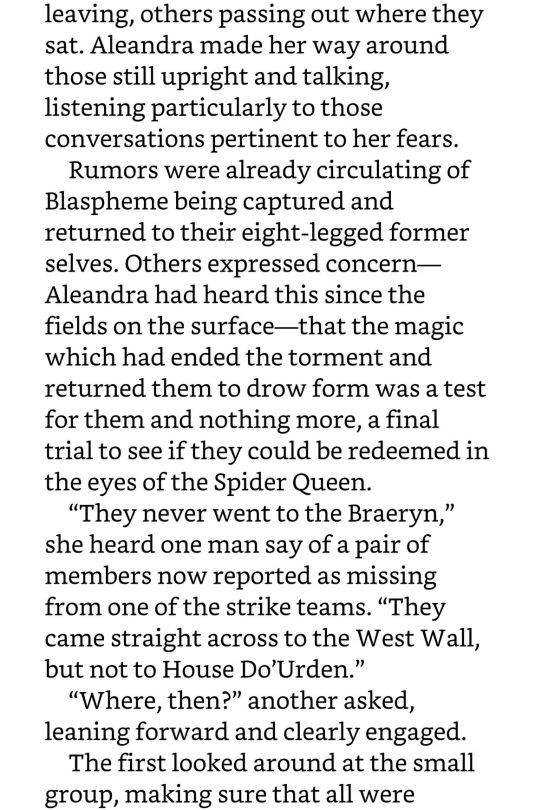

Although all of the driders had flung themselves through the transformative web to regain their drow bodies, Glacier’s Edge reveals that it didn’t equate to a unanimous turn against Lolth, even though the very act of undoing her curse is blasphemous against her. Much like with real people, the familiar can be more attractive than the unknown, even when the familiar is toxic. Further, much like real people, the Blaspheme convince themselves that it will be different, because not doing so would mean having to face the horrid truth, an act that’s just as scary as trying the unknown. It may very well be the case that the Blaspheme will willingly return to Lolth, although this is unlikely given the nature of the goddess, but regardless, it is a true to life portrayal of people.
I personally harbor a strong dislike for Drizzt due to the way that Salvatore portrays him, to the point that I’m not easily swayed due to the many books in which it’s shoved down our throats that he’s the embodiment of goodness. However, one scene in Glacier’s Edge improved my opinion of him. Grandmaster Kane recruits the copper dragon sisters Ilnezshara and Tazmikella to take them from the Monastery of the Yellow Rose back to Drizzt’s friends on the Sword Coast. Despite the agreement having already been established, and despite Grandmaster Kane already being in the process of mounting Tazmikella:


This one act of asking for consent is more convincing of Drizzt’s goodness than all of his journal entries, existing and to exist, ever will be. It shows him more worthy of respect than all the passages detailing his heroic exploits ever will. It doesn’t matter that Ilnezhara heartily approves and then proceeds to tease him with sexual innuendos alongside her sister, it doesn’t matter that we’re told that he’s afraid of how she can bite him in half. The very act of putting a saddle on a sentient creature, especially one as proud as a dragon who considers themselves superior to the races that are confined to walk on the ground, is inherently denigrating, and to then ride on that creature is even more so, no matter how it is played up to not be that way. Even though in practice, Ilnezhara holds all the power, the dynamic of mount and rider puts her in the lesser role, hence it’s so important that Drizzt treats her as a respected equal, maybe even further respecting her by implying that he acknowledges that she holds all the power.
In a book lacking much in the way of characterization, Archmage Gromph is the exception. In addition to being the only one who isn’t a raving fanboy of the Companions of the Hall, Gromph stays true to himself. It isn’t just haughty words and not at all empty threats against those who irk him, we see that Gromph hasn’t lost any of that hubris that’s made him appealing in his own way. After suffering a direct attack from a literal god, Gromph nonetheless remembers how to preen:


Gromph may not know that it’s a literal slaad god, but nonetheless, he knows the strength of his assailant. He’s grudgingly admitting that the creature is possibly stronger than him, after throwing a psionic attack that was only inferior to the collective might of one of the most powerful psionic entities in the multiverse. This does beg the question of just how powerful Gromph considers himself, but at the same time the answer doesn’t matter, for although he hasn’t met Elminster it’s pretty clear that he thinks he can take him. He’s wrong, of course, but nonetheless there’s a certain comical charm to Gromph pondering how awesome he is while facing down such a deadly foe. It’s incredibly fitting of him.
This concludes my section about the positives in Glacier’s Edge.
#legend of drizzt#Forgotten Realms#Glacier's Edge#The Way of the Drow Trilogy#Drizzt#Drizzt Do'Urden#R A Salvatore#book review#ooc
6 notes
·
View notes
Text
Checking out other Magical Girl shows Part 2
As part of my ongoing research for my fanfic (which is rapidly becoming an excuse to watch anime lol) I checked out the first episode of Cutey Honey F.
Now I should be upfront, I had researched and watched a few videos about Cutie Honey before watching this so I wasn’t going into this cold. Maybe that was a detriment, maybe that was a benefit as I took the premise at face value.
Nevertheless I honestly think that this was my favourite of all the Magical Girl shows I’ve checked out so far for this project.
A LOT of that has to do with the style of the show. Obviously you have the forever classic banger of a theme song and this show has a particularly great rendition of it. But it’s more than that because the music over all was simply stellar. What was most pleasing for me was that it felt like a cousin to Sailor Moon’s legendary OST. Sailor Moon’s soundtrack was influenced a lot by 1970s music (especially disco) and Cutey Honey was a product of that decade. As such the music for this 90s revival carries a lot of the same musical DNA.
In fact, this show over all feels incredibly reminiscent to Sailor Moon and more specifically my favourite season, Sailor Stars. IIRC from my research that is no coincidence. Cutey Honey F I believe took over Sailor Stars’ time slot and had staff members in common. I think this is most noticeable in the art style for the show.
I’m really not in the know when it comes to animation styles and such so this might just be a general 90s aesphetic thing, but the characters look REALLY similar to the designs seen in Sailor Stars with Honey herself looking very similar to Usagi in that season. And I’m A-okay with that because imo Sailor Moon never looked better than in its final season. By extension I think this is probably my favourite rendition of Cutey Honey in her fighting form. I haven’t seen the other versions of the character but I saw enough videos and documentaries to get a good impression of the character designs implemented in those shows.
The monster designs were also pretty cool and I in particular loved the Sister Jill scene as it was very reminiscent of Queen Beryl and Metalia from Sailor Moon Classic. Although given Cutey Honey’s large shadow within the Magical Girl genre perhaps it was the other way around.
Beyond the stylistic aspects of the show the story and characters seriously worked for me. Although we only got a cursory introduction to them the episode set up a supporting cast with relatively defined roles ripe for expansion going forward. I especially liked the touch of establishing Honey as a skilled sword fighter in her own right as opposed to her simply getting that skill via her transformation itself.
I guess maybe there might’ve been more done with her relationship with her father, but from my understanding there wasn’t all that much in the original show in the first place. Her father’s death was there as set up for her powers and motivations and then we moved on. Here we got at least a little insight into the depths of how much he loved her. Like the episode SOLD us on the love between these two people as opposed to us merely understanding it on a technical level because obviously a parent and child would love each other. To that end you do feel the gut punch when Honey is in denial about her father’s abduction, her home being destroyed and her father’s death. It seems like this episode took the general plot of the first episode of the 1970s show and essentially placed the emphasis in different places and for me that reprioritizing seriously worked.
Additionally I think the shift in demographic for the show worked out great. I’m no anime expert, let alone for shojo or Magical girls. However, it is my understanding that Cutey honey was originally intended as a show for a shojo, then got retooled to be a shonen and this show took the shonen incarnation and further retooled it to the shojo audience it was originally intended for. That is a fascinating creative evolutionary process all on its own. But I think that is why Cutey Honey, even when stripped (pun intended) of the most famous aspect of it (the racy transformations) and geared towards a totally different audience works and the stuff that (in my limited experience) I’ve identified as ‘typical shojo’ concepts and what not (the flower imagery being one example) feels like it fits naturally with the story and character.
In conclusion, I got more than enough material for my fic from this episode alone. But I plan on watching at least a couple more episodes of this anyway because I was just that impressed with it.
P.S. I lolled hard when Honey referred to herself as a flight attendant to Hell. Damn. Guess she doesn’t fuck around!
#Cutey Honey#Cutie Honey#Cutey Honey F#magical girls#Sailor moon#sailor stars#honey kisaragi#Panther Claw#Sister Jill#My essays
13 notes
·
View notes
Photo
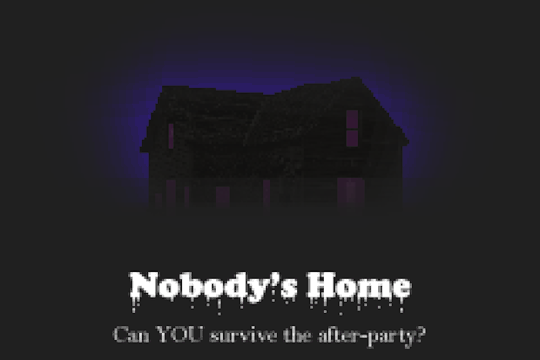
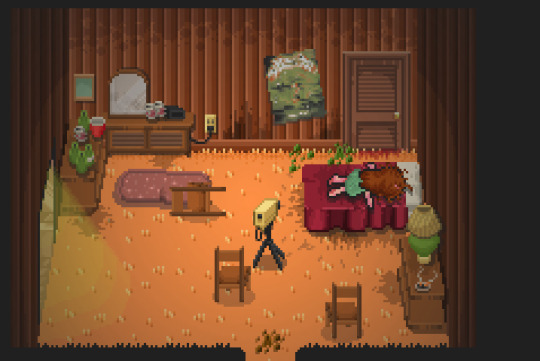


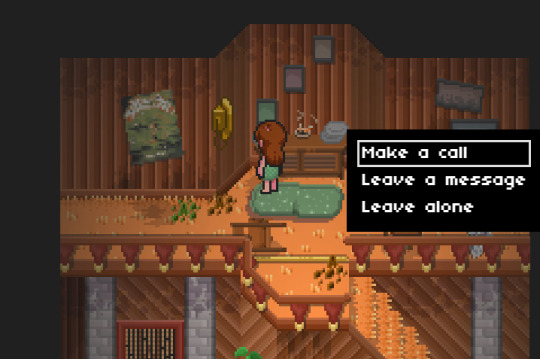
April’s Featured Game: Nobody's Home
DEVELOPER(S): oates ENGINE: RPG Maker MV GENRE: Survival Horror SUMMARY: After a night of extreme drinking and partying, you wake up in stranger's bed to discover... Nobody's Home.
Buy the game here! Our Interview With The Dev Team Below The Cut!
Introduce yourself! *oates: Hi, this is oates! I'm a pixel artist and game developer, I've started making games with rpgmaker in 2016 with VX Ace and now currently using MV for recent projects. Previous projects I've worked on were the FNaF-inspired Souls-like One Night at the Steeze, my first rpgmaker game and it's prequel, the FNaF-inspired roguelike No Delivery. Other games I've worked on include the fangames Day Dreaming Derpy, made in VX Ace and Spike's Day Off, made in MV and the latest in a series of previous fangames previously developed on Adobe Flash.
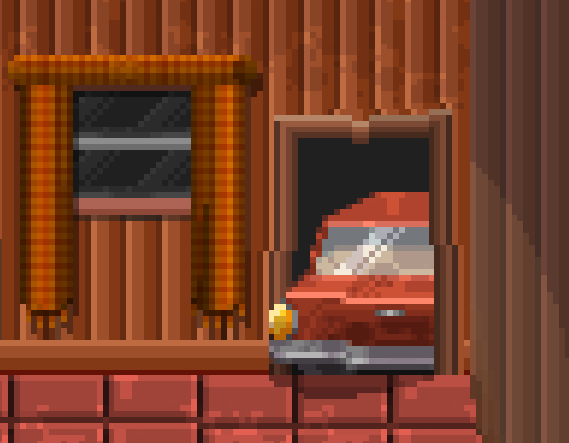
What is your project about? What inspired you to create this game initially? *oates: Nobody's Home is largely based on my experiments to find and apply horrific elements in modern situations or phenomena. The scenario being explored here in Nobody's Home is the aftermath of some crazy party. Sound design is especially important when crafting a horror scenario, so I often look to music to draw inspiration. Much of the atmosphere and house design was inspired by music and imagery associated with '70s yacht rock (a sub-genre of soft rock). Another important note is a lot of the general mood and 'weirdness' was inspired by a band I listen a lot to, Dance Gavin Dance, specifically their "deathstar" album. However they have a tendency in all their albums to switch genres mid-song, often going from their post-hardcore sound to funk, pop, and even rap; aside from that, some of the subject matter covered can range from disturbing to unpleasant to nonsensical, but combined with the amazing music, it creates an experience that pulls the listener in all different directions. It got to the point that I was naming events in the game after some their tracks so I had to be careful not to inadvertently make a fangame haha But there are some easter eggs in Nobody's Home that were intentionally left in, and I'm fairly certain players have identified it already.
How long did you work on your project? *oates: I used much of the same framework left over from my previous project No Delivery for this development cycle, so the hassle for setting up asset pipelines was very much mitigated. I started in earnest, making assets back in January this year so it took roughly 2+ months to finish development for this project.
Did any other games or media influence aspects of your project? *oates: Aside from the previous music inspirations, I was really intrigued with the way Resident Evil 7's Beginning Hour demo was able to pick up where Konami's cancelled PT left off in terms of survival horror games to look forward to back in 2017. Prior to later updates, the initial demo really only included a few set pieces, basic item interaction, and almost no puzzles from the full game. It was largely able to pull off scaring players from almost atmosphere alone (if you exclude the Jack Baker and ghost encounters). It was later in the full game that it was able to show off it's metroidvania-esque design to its fullest. After my previous project, I wanted to step away from roguelike design for a bit and focus a little more on an exploration-based experience, so I took a few notes from the way RE7 and RE2: Remake handled map design and progression.
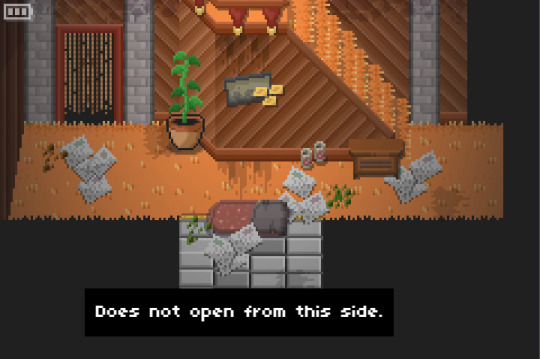
Did you come across any challenges during development? How did you overcome or work around them? *oates: I was coming off a severe cold last year and it took most of January for me to recover, so it was a little hard to start full-on development immediately like I normally would on top of other career matters. And looking at events today, it's even more imperative that developers practice healthy habits during development.
Did any aspects of your project change over time? How does your current project differ from your initial concept? *oates: I've had the idea for Nobody's Home as a concept for a while, but filling in those gaps with actual gameplay between centerpieces was a big variable. I went back and forth between the turn-based item combat from the previous project to cutting out combat entirely. While I didn't implement it, I also brainstormed a few concepts for overworld action and combat ala Zelda, but it seemed too complex given the time frame I set for myself. Eventually I settled on a middle ground between full combat and separate encounters, with "enemies" acting as essentially a toll gate. The rest of the game followed suit with various tolls and "mouse traps" for the player to trigger at their own behest. This wasn't necessarily the design I had in mind at first, but it helped to concisely fill a relatively small location with specifically "deadly" content.
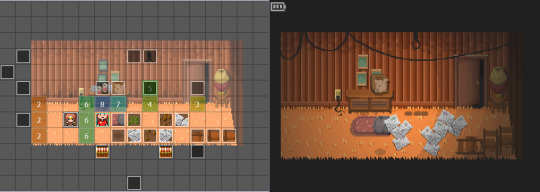
What was your team like at the beginning? How did people join the team? If you don’t have a team, do you wish you had one or do you prefer working alone? *oates: I largely work solo for both development and art, but I do regularly work with a few musicians for an original soundtrack. I first started working with other composers for the fangame Day Dreaming Derpy, where after the initial demo was released, I received emails from a few musicians volunteering to contribute some tracks for the game. In all, the original soundtrack contained 9 tracks in total, with 3 tracks from each composer; each of them doing an amazing job and, in my opinion brought the project back then to a higher degree of quality. This was how I met some of the composers I still work with today and they all have some really great work! TheNGVirus @NGVirusNG1 Kaminakat @thekaminakat dRedder @HornyGremlin
What is the best part of developing a game? *oates: It's a toss up between the initial brainstorming/research and the first run-through when you have your desired maps linked together. For the brainstorming, it's pretty fun to learn about subject matter you want to do justice to as well as stretching your creative muscles for the first time in service to a certain concept. However this obviously wears off when you devote too much time to a particular concept, but it's still enjoyable nevertheless. For making that run-through, it doesn't necessarily mean to have all the events implemented, but to experience your game the way players will experience it for the first time does give a sense of completion/cohesion to what you, as a developer, are trying to accomplish. It essentially puts what you're working on into a different perspective for you.
Do you find yourself playing other RPG Maker games to see what you can do with the engine, or do you prefer to do your own thing? *oates: I do keep an eye out for what other rpgmaker projects are doing, and to see what others can do with the engine helps get the creative juices flowing; it's also fun to try to mentally reverse engineer how certain mechanics or effects were made. And it's always great to see fellow devs showcase what's possible with the engine.
Which character in your game do you relate to the most and why? (Alternatively: Who is your favorite character and why?) *oates: Nobody's Home has a relatively small cast of characters, whom you do interact with but never see, this is largely to done to create a sense of "un-relatability", but if I had to pick a character, it'd be "car guy", the guy you find stuck in the car. They have a good line, " ...there'd be a good reason for this, but there isn't..." Story of my life.
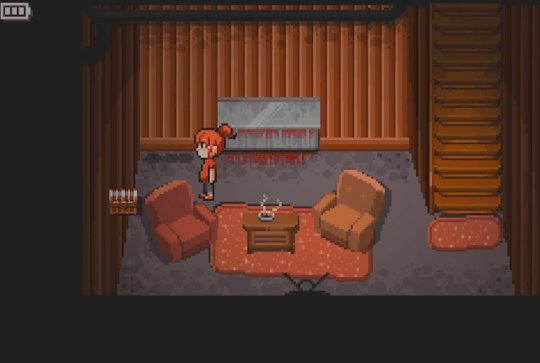
Looking back now, is there anything that regret/wish you had done differently? *oates: There were a few areas I would have liked to expand on or add, specifically- the attic + roof, the front lawn, behind the walls, and an entire second floor. Unfortunately that meant potentially adding more questlines and NPCs while the first set of questlines were pretty interwoven so it would have been way more complex, also again, given the time frame I set, it would have extended the development cycle way beyond what I had time for. But if I had implemented those extra areas, the game's length would also go way beyond the 30 min - 1 hr it takes to complete the game as it is now.
Do you plan to explore the game’s universe and characters further in subsequent projects, or leave it as-is? *oates: I'd like to do both really, each installment of the VCRPG line of games is definitely a stand-alone story, or an isolated incident, but I would love to explore the aftermath of the game's events and how the passage of time ravages and twists the story into urban legend. I like to treat places and environments like characters as well, capable of making memories, being misunderstood, preserved, destroyed, and ultimately capable of change.
What do you most look forward to upon finishing the game? *oates: Both the fan reaction and free time honestly speaking. Once the development cycle finishes and the game is published, your work isn't really finished as there's always a chance someone's feedback can apply to immediate changes or patches you can implement, even during the release period. Marketing is also another large step to take into consideration after release, this includes tweeting, sending keys for lets plays, etc. Watching playthroughs is also a really good way to collect data on what parts of your design fall through and what fail to land. But after all that is said and done, some free time really helps the brain recuperate.
Was there something you were afraid of concerning the development or the release of your game? *oates: Just whether or not I handled the game's subject matter tastefully. Like horror cinema, everything done is in service the the themes and message of the piece as a whole.
Do you have any advice for upcoming devs? *oates: The game engine is essentially a tool, and like any tool you can find plenty of creative ways to get the same result. And don't be afraid to research whatever it is you need help with, it also helps to be specific with what you want.
Question from last month's featured dev @moca-pz: If you can collaborate with any game developer in the world, who would it be? What would be their role(s) and what would be your role(s)? *oates: Game developer I'd like to work with: Hidetaka Miyazaki His role: Story Lead and Director My role: Drinking buddy Game we're working on: SciFi Souls
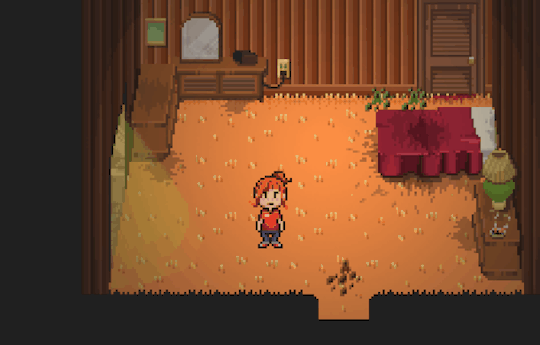
We mods would like to thank oates for agreeing to our interview! We believe that featuring the developer and their creative process is just as important as featuring the final product. Hopefully this Q&A segment has been an entertaining and insightful experience for everyone involved!
Remember to check out Nobody's Home if you haven’t already! See you next month!
- Mods Gold & Platinum
#rpg maker#nobody's home (game)#nobodys home#nobody's home#game#rpgmaker horror#pixel horror#horror game#indie game#gotm#game of the month#oates#gotm 2020#2020#april#april 2020
329 notes
·
View notes
Video
youtube
With no time to waste, we have a tremendous news update on Dragon Age 4’s current iteration known as “Morrison”, as many development secrets were revealed in BioWare’s brand-new hardcover book of “Stories and Secrets from 25 Years of Game Development.”
A lot of the questions that we’ve all been asking over the past few years, finally have an answer, all thanks to this book. I will be delving into all of the Dragon Age 4-related content in this book; however, I wholeheartedly advise you pick up the book for yourself because it is filled to the brim with insights, information and behind-the-scenes reveals on every BioWare game to this date.
It’s full of so many captivating, inspiring and amazing stories that showcase BioWare’s incredible journey over the past 25 years.
In any regard, we’ve got a lot to get into, so leaving no stone unturned, we’ve got some updates regarding Dragon Age: Morrison, the current-rebooted project code name of the next Dragon Age game.
Morrison:
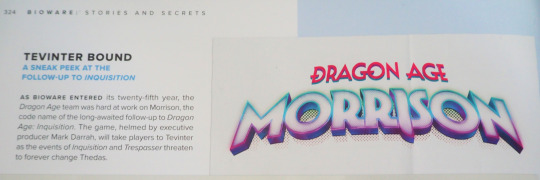
Along with this amazing retro-styled font of Morrison’s code name - that I’m totally going to use in future videos and thumbnails - we actually have a small plot synopsis on this working title.
It reads as followed: “Tevinter Bound – a sneak peek at the follow-up to Inquisition.”
“As BioWare entered its twenty-fifth year, the Dragon Age team was hard at work on Morrison, the code name of the long-awaited follow-up to Dragon Age: Inquisition. The game, helmed by executive producer Mark Darrah, will take players to Tevinter as events of Inquisition and Trespasser threaten to forever change Thedas.”
We’re going to Tevinter! Of course, we already knew that based on Trespasser’s ending, Tevinter Nights, and the developers already hinting that, but it is still very nice to see hear that in a plot outline.
In addition, the most interesting factor about this synopsis, is that for the first time BioWare have confirmed that “Morrison” is indeed the code name for the current Dragon Age project, which outrightly confirms that Jason Scheirer’s Kotaku article on “The Past & Present of Dragon Age 4” carries merit and truth to it, meaning that we can indeed trust the entire contents of Jason’s article.
Regardless, sticking with the 80’s retro theme, BioWare staff have themed shirts for the project, and they look absolutely amazing. Please, BioWare Gear Store release these one day, if at all possible, these designs are so good!
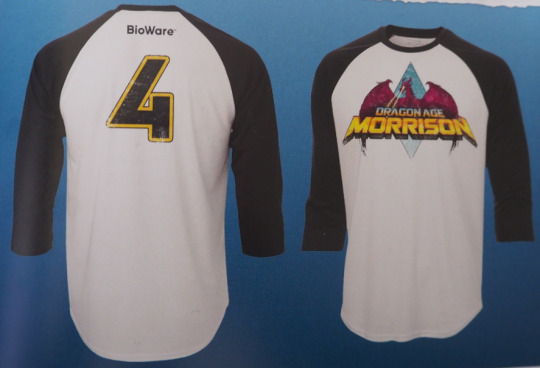
The book then goes on to show very familiar concept art that was showcased within the Gamescom behind-the-scenes trailer, however, this time, we have actual descriptions on each of the art pieces, and what they’re portraying. So, we don’t need to spend another 40 minutes speculating about what the pieces could show.

The underwater shot which we assumed to be Isabela accompanied by what looks like Dorian with a sword, an undead and a female dwarf, appears to showcase the Lords of Fortune, a newly-introduced faction within Tevinter Nights.
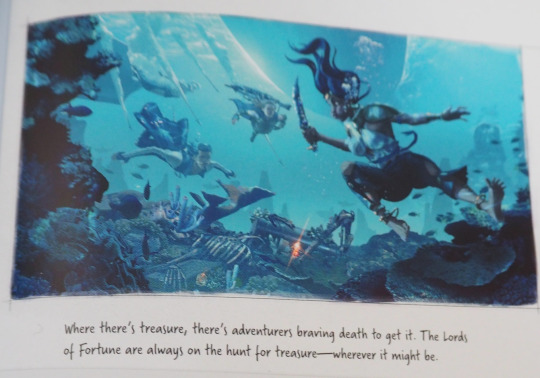
The synopsis says:
“Where there’s treasure, there’s adventurers braving death to get it. The Lords of Fortune are always on the hunt for treasure-wherever it may be.”

The next shot, which I speculated it as Tevinter’s capital city Minrathous, has a synopsis that says:
“The glittering hubs of Thedas are beacons of civilization and bulwarks against the night.”
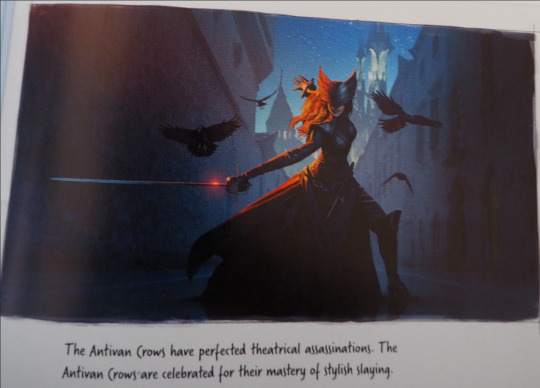
Following that, we have the mysterious Antivan Crow lady concept art with the synopsis:
“The Antivan Crows have perfected theatrical assassinations. The Antivan Crows are celebrated for their mastery of stylish slaying.”
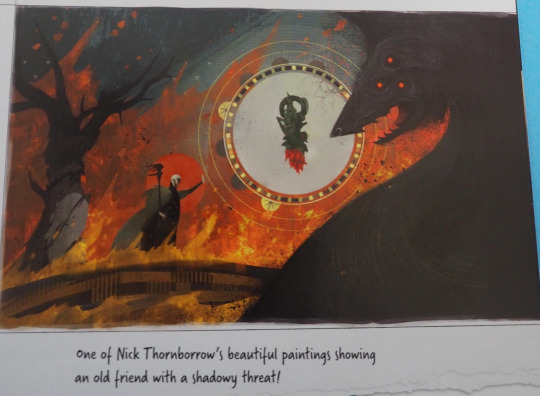
And then we have a most recognisable mural, one that many of us have spent way too long staring at, tinfoiling over its endless possibilities. The synopsis of The Dread Wolf Rises concept piece says:
“One of Nick Thornborrow’s beautiful paintings showing an old friend with a shadowy threat!”
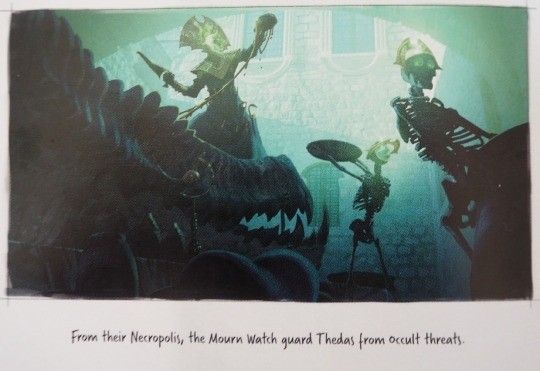
Following that, we have Nevarra’s undead operating on a dragon, with the synopsis saying:
“From their Necropolis, the Mourn Watch guard Thedas from occult threats”

And then we have – hold on, what’s this, a new piece of concept art? Roll on the tinfoil, I’ll read the synopsis first and then we can go from there, as it states:
“The Deep Roads teem with evils both new and old, known and unknowable.”
I won’t spend ages delving into a single piece of concept art, but we can see the Deep Roads with plenty of light coming from the surface. It’s a beautiful shot, that I’m sure is building a mood for potential locations in the next game.

The final concept art piece shown is one from the trailer, however, it’s not cut-off anymore. When it once looked like an evil Cetus, it now reveals something even more wicked than a sea dragon... A figure with multiple arms, red eyes, a curved headpiece, holding a spear. Is this an ancient God? Could it be Ghilan’nain? A Lovecraftian sea-hybrid-monster? Or is it just a crazy idea thrown together by a concept artist, because why not?
The synopsis is the most intriguing and provides a further context for the next Dragon Age game:
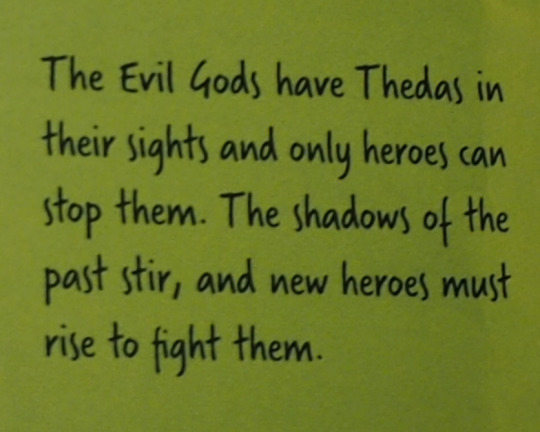
“The Evil Gods have Thedas in their sights and only heroes can stop them. The shadows of the past stir, and new heroes must rise to fight them.”
There are many “gods” in Dragon Age, the Old Gods, the Elven Gods, the Maker, the Titans, etc. You could certainly consider each of them to be evil too, but on a whim, with the whole “shadows of the past stir.” I’m sure this synopsis is referring to the Elven Gods, given Solas’s scheme that will return the Evanuris to Thedas once more.
Taking my tinfoil hat off for a moment, this book expertly describes concept art stages relating to BioWare, and I need to touch on what exactly these pieces could mean going forward, because they most certainly could just be conceptual drawings without much context for the next game.
The book quotes Dragon Age 2’s development regarding concept art, saying:
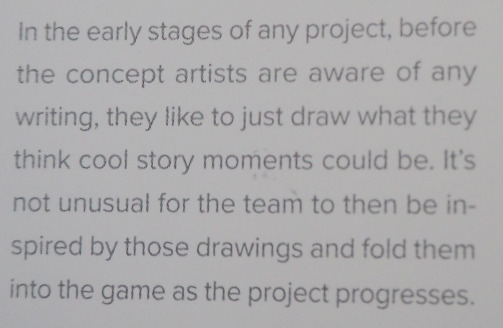
“In the early stages of any project, before the concept artists are aware of any writing, they like to just draw what they think cool story moments could be. It’s not unusual for the team to then be inspired by those drawings and fold them into the game as the project progresses.”
And, even further than that, Matt Rhodes, who is the Art Director of the next Dragon Age spoke a few words regarding Dragon Age: Inquisition’s conceptual art stages:

“As multiple teams worked on their corners of Inquisition, lead concept artist Matt Rhodes spent weeks creating images to help solidify and drive a vision of what the game could be.”
“It was partly to encourage and remind myself of what the potential of this project could be,” Matt says. “We all imagine the finished game. I wanted to get that on paper, to remind everyone we are making something that could be pretty cool.”
So, while we’re all so excited to see these amazing concept designs and imagery, and we love to correlate it all to the next game, remember that these designs are very early work building a vision for the next game, they’re just being used to represent what idealistically the developers would like the game to end up like, or what insane ideas the concept artists have for the game.
Many of these ideas won’t turn out in the final product, but it’s still so nice to see this work already.
Wolf Rook Book:
Moving on, we can put an end to a five-year mystery, we finally have answers on that enigmatic red “Wolf-Rook" book that Mark Darrah has teased for half a decade.

One of my first ever videos on this channel was delving into the early pages of this book, back then I had a hunch that this book was the next Dragon Age game’s early concepts and designs, like a shiny development doc for the team.
And I was on the right tracks, as followed:
“The book was an internal guide for developer and publisher eyes only that summarized the vision for Dragon Age: Inquisition’s follow-up, a project code-named Joplin. The Joplin project has since been revised to such an extent that its code name changed to Morrison, but the red book still contains plenty of ideas likely to appear in the next Dragon Age. While most pages remain highly classified, here are a few Mark said we can publish.”
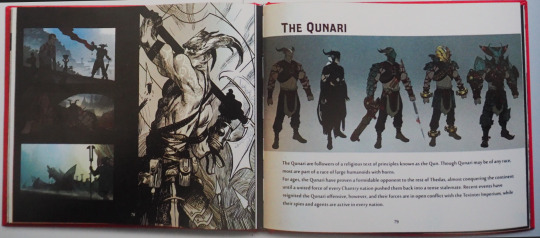
There’s a small description of The Qunari with some other concept shots, the paragraph reads as followed:
“The Qunari are followers of a religious text of principles known as the Qun. Though Qunari may be of any race, most are part of a race of large humanoids with horns.”
“For ages the Qunari have proven a formidable opponent to the rest of Thedas, almost conquering the continent until a united force of every Chantry nation pushed them back into a tense stalemate. Recent events have reignited the Qunari offensive, however, and their forces are in open conflict with the Tevinter Imperium, while their spies and agents are active in every nation.”

And at the bottom we have a Creatures double-spread page with different concepts very similar to those seen in Inquisition, the paragraph reads as followed:
“Animals, monsters and misplaced magical experiments: creatures stir apart from the conflicts and machinations flowing across the continent. Creatures range from the lowly nug up to the ultimate apex predator, the dragon. The next Dragon Age will feature our widest and most varied set of creatures to date. While often quite simple in implementation, creatures provide variety through differentiated animation and appearance.”
So, “Wolf-Rook” is still relevant, somewhat confirming that the work that went into Joplin, may cross over into Morrison, which is very exciting because Joplin’s vision for a Dragon Age title sounded amazing, so to hear aspects of that work pouring into this new project is absolutely fabulous. I had a hunch that the red book was still valuable to the current project, because we’ve seen a lot of “Wolf-Rook” teased this year, Mark Darrah has not stopped showing off his stash of red books. So, I’m very glad it’s here to stay for the current iteration.
Dragon Age Week:
Next up, we have an update to a story I talked about in March of this year, Mark Darrah teased a picture of his laptop with the BioWare Slack server shown at the bottom of his screen.

One of the channel-titles within the server was one by the name of “DA Week”, and thanks to this book, we know what “Dragon Age Week” actually is:
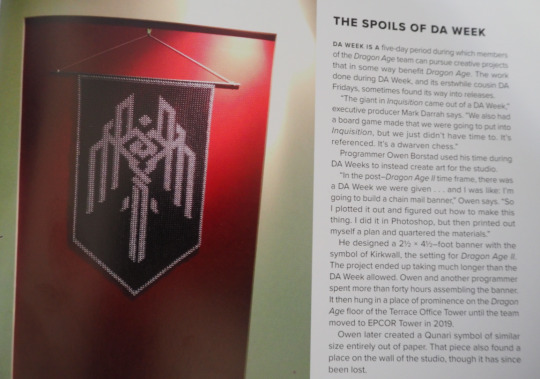
“Dragon Age Week is a five-day period during which members of the Dragon Age team can pursue creative projects that in some way benefit Dragon Age. The work done during DA Week, and its erstwhile cousin DA Fridays, sometimes found its way into releases.”
“The giants in Inquisition came out of a Dragon Age Week,” executive producer Mark Darrah says. “We also had a board game made that we were going to put into Inquisition, but we just didn’t have time to. It’s referenced. It’s a dwarven chess.”
So, I do wonder what kind of ideas have come out of Dragon Age Week recently that has then ended up in the next Dragon Age. Hopefully, one day we’ll have a new book that tells us Dragon Age 4’s secrets and we can visit this topic.
New BioWare Vision:
Moving on to the final major update, thanks to this book, we have a greater understanding about the vision BioWare have going forward. According to General Manager, Casey Hudson and Dragon Age, Narrative Director, John Epler.
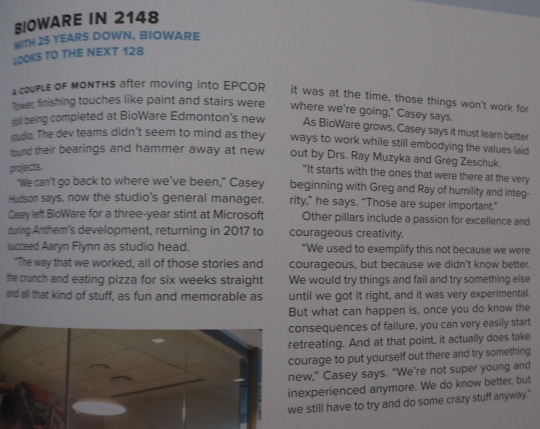
Casey Hudson spoke on the “old” BioWare and how their changing paths to a “newer” BioWare:
“We can’t go back to where we’ve been,” Casey Hudson says, now the studio’s general manager. “The way that we worked, all of those stories and the crunch and eating pizza for six weeks straight and all that kind of stuff, as fun and memorable as it was at the time, those things won’t work for where we’re going.”
As BioWare grows, Casey says it must learn better ways to work while still embodying the values laid out by Drs. Ray Muzyka and Greg Zeschuk.
“It starts with the ones that were there at the very beginning with Greg and Ray of humility and integrity,” he says, “Those are super important.”
Other pillars include a passion for excellence and courageous creativity.
“We used to exemplify this not because we were courageous, but because we didn’t know better. We would try things and fail and try something else until we got it right, and it was very experimental. But what can happen is, once you do know the consequences of failure, you can very easily start retreating. And at that point, it actually does take courage to put yourself out there and try something new.”
Casey says. “We’re not super young and inexperienced anymore. We do know better, but we still have to try and do some crazy stuff anyway.”
John Epler shared on the change going on within BioWare:

“I am excited for what the future holds. I think BioWare is changing. I think we’re at a crossroads where we can either accept that and move into the new BioWare, or we can try to cling to the past. We have to be respectful of our origins without being constrained by them. It’s an exciting time and I’m really looking forward to what the next five years brings.”
“’I’m one of those people who is probably going to be here until they have to literally wheel my desiccated corpse out of the building, because I love working here and I love the people I work with and I love getting to come into work every day to have long, detailed conversations about how eluvians work.”
All in all, I’m incredibly excited and optimistic for BioWare’s future, they’re aware of their flaws, while knowing what makes them great. They seek to humble themselves, while changing direction, they want to avoid crunch while being experimental. I think we’re going to see the company bloom when they inevitably release the next Dragon Age, and I am totally here for that.
Dragon Age Day
Before I leave you, Dragon Age Day is quickly approaching, and it seems BioWare have plans this year. EA Community Manager, Jay Ingram tweeted about fans asking questions for the Dragon Age team, in prep for plans on Dragon Age Day. I’ll link the tweet down below, so you can ask as many questions as you’d like! It seems that BioWare may stream on Dragon Age Day, so do watch out for that, and give them a follow on their Twitch, also linked down below:
https://twitter.com/JayKingIngram/status/1325197450907275264
https://www.twitch.tv/bioware
Regardless, this is where we part ways. There was so much that this book uncovered, I highly recommended picking It up for yourself, it’s truly worth it to any BioWare fan. There was also some future Mass Effect stuff, but I’m saving that for a future video that I’ll do at the start of the new year. And I most likely will do future videos on other topics revealed in this book.
#dragon age 4 news#dragon age news#biowar#bioware 25 years#dragon age update#morrison#joplin#wolf rook book#mark darrah red book#mark darrah slack server#dragon age week#next dragon age#concept art#dragon age concept art#dragon age 4#dragon age 4 concept art#the dread wolf rises#da#da news#tevinter bound#imperium#tevinter#thedas
37 notes
·
View notes
Text
It’s been a while, what with me being being more active on Twitter these days, but I had some thoughts churning around in my brain and this felt like a better place to post them rather than threading them over there.
This is a post about Persona 5 and restorative justice. Before I go any further, though, a note: this is meta about restorative justice and prison abolition as ethical philosophies only, how it can be expressed/structured in works of fiction, i.e., Persona 5 and Persona 5 Royal, and what the importance of doing so is.
I should also note that I am not a philosopher, a legal scholar, or an activist, I just like to read, and I strongly encourage you to look into the topics I’m discussing in this essay. If you want specific recommendations you can DM me; again, this being meta about a video game, I think linking those titles here would diminish their importance regarding what they’re actually about.
Ready? Okay. Let’s get started.
what is restorative justice?
‘Restorative justice’ is a concept in ethical and legal philosophy that holds itself in contrast to two other kinds of justice: punitive and carceral. Punitive justice is justice as punishment, i.e., an eye for an eye, while carceral justice involves justice as the confinement of criminal offenders. While both have heavy overlaps with one another, they’re distinct in the generality vs the specificity of their outcome: punitive justice can involve the death penalty, property seizure, permanent loss of rights, etc., carceral justice refers strictly just to the incarceration of criminal offenders in institutional facilities (jails, prisons, etc.).
Restorative justice, in contrast, roots itself in the understanding of closing a circle: the best and most holistic way to heal harm one person inflicts on another is to have the person who inflicted the harm make reparations to the person they hurt in a tangible and meaningful way. This can take many forms, and if you’re passingly familiar with restorative justice already, you may have heard about it involving the offender and the victim meeting face-to-face. This does happen sometimes. Personal acknowledgement of the harm you’ve inflicted on someone is important, and direct apologies are important, but these need to also be coupled with actions. The person behind a drunk hit-and-run of a parent could help put their orphaned child through school, or a domestic abuser could be made to take counseling and go on to help deter domestic violence in other households, and so on.
The vast majority of states across the world use punitive/carceral models, though small-scale community trials of restorative justice have been attempted, to varying degrees of success. No one is going to argue that it would be easy to implement, but it is important. Restorative justice is about recognizing that crime, specifically crimes against other people, are fundamentally still about two people: the perpetrator and the victim. And we have to look beyond the words perpetrator and victim to recognize that they are both human beings and challenge ourselves to build a society where our concept of justice means healing hurts instead of retaliation.
It’s not easy, but it is possible. It requires changing your own perceptions of justice and humanity and society and the big wide entire world to have the kind of mindset that allows it to be possible. But it is possible, and I know that from personal experience, because it’s my own mindset and I’ve been through trauma too.
prison abolition and the god of control
Persona 5 has an authority problem. By which I mean, Persona 5 has a problem challenging authority in any way that functionally matters.
The game is drenched in heavy-handed prison imagery, from jail cells to wardens to striped jumpsuits to cuffs and chains to an electric chair. Throughout the long build-up of the main storyline we’re treated to a confectionery delight of punitive justice, stick-it-to-the-man justice: the Thieves find a bad guy who coincidentally has personally hurt or is actively hurting one of their members, and they take it upon themselves to make the bad guy miserable and then send him off to jail. By the end of the arc you’re meant to feel like you accomplished something heroic, that by locking someone up you’re balancing the scales of justice. In the Kamoshida arc Ann even frames this in restorative justice terms, telling him he doesn’t deserve the easy way out of ending his own life and needs to live with his mistakes and repent, but he’s still sent off to jail regardless and Ann and Shiho are left to struggle through the trauma he put them through without anyone to really support them. This repeats itself, over and over: Madarame, Kaneshiro, Okumura, Shido--expose the bad guy, bring him low, publicly shame him, and then send him away (or, in Okumura’s case, watch him die on live TV to riotous cheers from the public).
And what does this all accomplish, in the end? You get to the Depths of Mementos on Christmas Eve to find the souls of humanity locked away in apathy, surrendered willingly to the control of the state, and your targets right there with them, thanking you for helping them return to a place where they don’t have to think of other people as people any more than they did before. In prison, they can forget that they are human beings and that all of the rest of the people in the world are too. The Phantom Thieves march upstairs and defeat the Gnostic manifestation of social control, that being that masquerades itself with lies as the true Biblical god. And then you go back home and the adults tell you that everything is okay now, the system itself isn’t rotten, and you just have to sit back, stop actively participating in the world, and let them take the reins.
It’s one of Persona 5′s most ironic conceits. “Prison abolition....good?” the player asks, and Atlus swats you on the hand and says, “Silly kids, prison abolition completely unnecessary because you can trust the state to not fuck up anyone’s lives anymore ever.” All while using prison imagery to present prisons as institutions inherently divorced from what might constitute actual justice.
Prisons exist because hierarchies exist, and so long as hierarchies exist, inequality will exist and people will commit harm who otherwise likely would not. But you can’t have your cake and eat it too, Atlus. You can’t frame prisons as an inherently unjust institution used to control people because you didn’t do anything to get rid of the hierarchy. You just gave the hydra a few new heads.
restorative justice and rehabilitation
Rehabilitation is Persona 5′s favorite buzz word, and for all that it’s used the game never really clearly defines what it’s supposed to mean. Yaldabaoth uses it as a euphemism to describe the process by which he creates his ideal puppet, but Yaldabaoth bad, and by the end of the game, Yaldabaoth dead. We get barely any time with Igor after that for Igor to define rehabilitation properly on his terms, which is notable in that Igor is the one who’s supposed to be the spiritual mentor of the wild card within the Persona universe.
We can only infer from that that it’s the player who’s meant to define what rehabilitation is by the end of the game, but because the game fails to take any concrete stance on its themes that could in any way undermine the idea that society isn’t functionally broken, it’s hard to figure out what conclusion we’re supposed to draw. As I stated above, the game immediately walks back any insinuations that it’s the institutions themselves that are rotten by having Sae and Sojiro step in and assume responsibility for making the world just by continuing to operate within the rules society itself has created. If you can’t beat them....join them?
If anything the closest we can get to coming up with a definitive understanding of what the game wants us to understand rehabilitation as is when the protagonist is in juvie. During those months we’re treated to an extended cutscene of all of your maxed out confidants taking action to get you out of jail, but because you can trigger this scene even if you haven’t maxed out all of your confidants, and because the outcome (getting out of juvie) is the same even if you haven’t maxed out any besides Sae, then we’re right back where we started.
But that cutscene still has a sliver of meaning to it despite it being largely window-dressing, because the game does push, over and over, the argument that it’s through your bonds with others, through building a community, that you’ll rehabilitate yourself and find true justice.
And that’s what restorative justice is about: community.
the truth: uncovering it vs deciding it
I can’t find enough words to convey how infuriating it is that Atlus comes so close to telling a restorative justice narrative and then completely drops the ball on displaying it at all in Goro’s character arc.
Goro’s concept of justice is fundamentally punitive, the textbook “you hurt me so I’m going to hurt you back.” In doing so he goes on to hurt a whole bunch of other people: orphaning Futaba, orphaning Haru, triggering a mental shutdown in Ohya’s partner Kayo, and also killing countless millions other instances of mental shutdowns, psychotic breakdowns, bribery, and scandal that caused people material harm and, in a handful of cases, killed them.
Yes, Shido gave him the gun, but Goro pulled the trigger. And in a restorative justice framework, you don’t bypass that fact: you actively interrogate it.
There’s been a lot of really great meta about what the circumstances of Goro’s life were like, including the Japanese foster care system, the social stigma of bastardy in Japan and the impact it has on an illegitimate child’s outcomes, and the ways in which Shido groomed and manipulated Goro into being the tool of violence he made him into. These things aren’t excuses for what Goro does, however: they’re explanations for it. They are the complex social issues that create a situation where a child feels his best choice, indeed maybe his only choice, is to take the gun being offered to him and use it on other people. If you want to prevent more kids from slipping through cracks into those kinds of situations, you need to understand the social ills that made those cracks appear in the first place and you need to fix them. Otherwise there will always be another kid, and another recruiter, and another bad choice, and another gun. Systemic problems require systemic solutions.
Even so, none of that bypasses the fact that it was Goro’s hand on that gun, that it was Goro who performed the physical action of killing Wakaba’s and Okumura’s shadows, and that, as a result of Goro’s direct actions, Wakaba and Okumura died. You can say Okumura deserved it all you like, but Haru doesn’t deserve to be an orphan. Haru deserved to repair her relationship with her father. Okumura deserved the chance to learn and make direct, material amends to the employees he hurt and the families of those who died on his watch, and they deserved to have him give them a better way to heal.
But this isn’t about the loss of Okumura making amends to his family or his victims: this is about Goro Akechi, and the fact that even in Royal his fraught relationship with Haru and Futaba is never explored, barely even addressed. There’s not even any personal, direct acknowledgement from him of the pain he put them through.
You can say he doesn’t care, and that’s fine that he doesn’t care. And it is. He’s a fictional character, this is a video game, they are anime characters.
But Persona 5 flirts with the idea of restorative justice and never fully explores it, and it’s a weaker game for that.
the thin place, the veil between worlds, the line in the sand
This is the last part, I promise, and I’ll be short and brief here, because the truth is that none of this matters, at least not in the way that you think. Persona 5 is a story. It’s a lie that we buy. It’s all zeroes and ones and electrical signals and optical images on a blank black screen.
But art can be powerful. Art is like magic, the deepest magic, the oldest kind. We human beings are creatures of art and poetry, of images and patterns, of music and words. Good art, really good art, can allow us to explore new ideas and critique our internal assumptions about how the world works.
No, fiction doesn’t affect reality, not the way that you think it does.
But if you’ve gotten this far, I just got you to read an essay on restorative justice and prison abolition in regards to a Japanese role-playing game, and that is something to think about.
How do you define rehabilitation? What kind of justice do you believe in? Is the way you conceive those things really the best way?
And how much more interesting could a story that challenges those concepts be?
51 notes
·
View notes
Text
February 8: Mountain Lion Mean Notes
Okay, so I was writing up notes on my Troped Western fic and then I clicked something and it all disappeared! I’m very upset and I hate the idea of starting again but like... I guess that’s what I gotta do :/
Mountain Lion Mean on AO3.
Written for @troped-fanfic-challenge
So as I said in my notes, I watched Hell or High Water on the Sunday the trope document opened and immediately became obsessed, and that was my main inspiration. I saw it and loved it and, like with most things I love, my first thought was how can I do this too?? I didn’t want to do a straight AU of it, because it’s just too good and I don’t want to mess with that kind of perfection, but I knew I wanted a similar mood. I also figured pretty early on that I would try to include a bank robbery.
For the first days after the trope doc opened, I mostly just gathered inspiration and tried to think Western thoughts. In addition to HOHW, my inspiration included:
The Western episode of Charmed
A Western Rock playlist I found on Spotify
This post of southwestern gothic aesthetics
“Ranch Girl” by Maile Meloy (also the inspiration for it is new moon and twilight, which, fun fact, was originally going to be a Western; I didn’t re-read the story but it’s been haunting me since I first read it c. 2001 and is probably a partial inspiration for everything I write)
William Faulkner (especially “A Rose for Emily” and A Light in August) for the “town POV” narration
Sigrid Undset for the floating third-person-POV
The wikipedia article on Westerns, for succinct summaries of the themes of Westerns
The original aesthetic, quoted from my notes: “The vastness of the west, the frontier, a little uncivilized, a little dangerous, tough looking men who don’t talk much, extrajudicial justice, the heat and the desert…“
By the time I sat down to brainstorm, I had a few ideas and a few images already in mind. I wanted to include a bank robbery. I liked the idea of Clarke as a gunslinger and/or purveyor of vigilante justice. I thought I might use Gina as a bartender (this was during the half-moment I thought I might write a Bartender Mechanic fic; obviously neither of these things happened). And I liked the idea of including Murphy as some kinda criminal or unsavory type. The image of Bellamy as a taciturn cowboy came fairly early too.
I was a little uncertain at first if I wanted to do an 1800s western or a neo-western, mostly because I felt like the tropes I was attracted to and the images in my head fit better in the 1800s. But ultimately I settled on neo-western pretty fast, because I thought the imagery and themes would work better in the modern day. Plus I just thought it would be easier tbqh.
My first concern was to not just re-write a shittier HOHW. I was really caught up in the logistics of the bank robbery; including too much of that would necessarily make it a copy of the film, so I tried to keep just the bare bones of the robbery + the general justification (saving the family land). Then I added additional portions of the scheme--not too difficult since I knew I wanted Gunslinger/Vigilante Clarke in there, and I needed some way to show that she takes Justice into her own hands--and additional characters. Again, most notably Clarke, but also Raven and Octavia. The characters have their own backgrounds, personalities, relationships, and motivations, all of which make the story more mine imo. I’m satisfied with the balance of Obvious HOHW Influences and original content.
At some point, I described it to my mom as “Bellamy is Toby, Murphy is Tanner, and Clarke is canon Clarke but in the modern West.” Which I still think is accurate.
Including Clarke, though, and privileging the various relationships among the trio of Bellamy, Clarke, and Murphy, made me feel like I was making an it is new moon and twilight knock off except with Clarke for Raven. I still kind of see it, tbh, in the sense that twilight was itself supposed to be a western--I think it would be fair to say that Mountain Lion Mean IS the fic I set out to write in February 2020--and in the sense that I could have written a different story in the same universe as Mountain Lion Mean that explored the Clarke, Murphy, and Bellamy relationships in a way that is similar to twilight. As is, a lot of that is unsaid and unseen. The two fics have different focuses, so it’s probably only apparent to me just how similar they are. Just like, to me, Mad Women and The Wanheda Tape are the same story even though they have very different aesthetics and plots.
Some excerpts from my notes that I think are fun:
I really want to work with the themes (haha themes) of frontier justice and also the sense that the west is infinite but also small, that nature is hard and impossible to wrangle but that the opportunities are narrow and it’s easy to get trapped in it, the melancholy nature of it, the dichotomy of nature (huge, powerful) versus man (small, struggling against nature and against man). Or some such. Or Murphy just robs banks.
Bellamy owns a struggling ranch. Clarke is a gunslinger (don’t really know if I can use this trope in the current day but possibly?) who doesn’t trust the law. Has a conceal[ed]-carry permit. Is the best shot in three counties. Murphy’s been in and out of prison most of his adult life, mostly for crimes like robbery and assault.
How do they know each other? Possibilities: Murphy knows Bellamy through Octavia (idk why…but I do feel like O should appear, riding a horse) (background Octaven? Just a thought), Bellarke are exes, Murphy used to work on the ranch. Clarke has killed someone (someone Bad) and gotten away with it.
I do like the focus being on these three characters, who have a long history but aren’t currently close, coming together for a mission (to rob a bank) for the benefit of one who is struggling (Bellamy) even thought this is an awful lot like both Hell or High Water and it is new moon and twilight lmao.
I like that mood from HOHW where actually Toby was the most dangerous, and the smartest, and he won—the idea that Bellamy is the taciturn cowboy who’s not good at sharing his feelings but he’s also the mastermind in the end. Is that the twist? You get the impression Vigilante Gunslinger Griffin and Actual Ex-Con Murphy are planning something, but then it turns out to be Bellamy who executes the plan? [Not quite how it turned out lol in that I think it’s decently obvious that Bellamy was a major part of it the whole time but I did try to get some of this in with Octavia in the final scene--to really drive home Bellamy’s importance, as the ring leader, since otherwise one could ask, what does he even do?]
Midway through the planning process I came up with some more images to work from:
B and C out at dusk on the ranch, she’s shooting can, a bit of UST perhaps
M shows up at the bar and there’s an awkward silent entrance—perhaps he’s just out of prison
Murphy or Clarke guns akimbo [I picked Clarke to emphasize that she’s the gunslinger, but I had Murphy shoot out the security cameras to show that they were using his robbery experience]
Bellamy being silent and awkward
At this point, it was just about putting all the pieces together. That’s how I tend to plan Troped fics: I lay out all the pieces I need or want to include and then I figure out the shortest and most efficient distances between them. For example, I knew I needed a bank robbery and for Clarke to administer some vigilante justice--so I use that justice as a way to launder the money. They fake a will for her victim and “give” the money to themselves.
I did worry, and still worry, about the timeline re: the Bellarke marriage and the will because I’m quite sure it doesn’t make sense and doesn’t work. But it also... it doesn’t keep me up at night because the whole point is that it’s a scam!! Worrying about legality in a scam is sorta... lol. What I mean specifically is that I wanted it to be clear that Clarke does not kill Kane FOR this scheme. They use something she already did to their advantage. So she and Bellamy can’t be married at the time Kane is killed. That implies the murder was pre-meditated for the bank robbing purpose. But I’m also fairly sure (and I should know this because I took T&E but like...honestly can’t remember) that the people in the will are counted at the time of death, not the time of probate, or you could like... adopt extra kids or marry or divorce someone to affect the will. Plus all that stuff about simultaneous death etc. etc. Also, on a practical level, if Clarke wasn’t married, Kane wouldn’t have an obvious reason to write her spouse into the will. But I get away with this in my head by saying, first, no one’s going to say the husband that’s standing right there doesn’t count as a husband--the law is the law but it’s implemented by people and they fudge corners all the time. They do what seems to make sense even if you’d lose points for it on a law school exam. And second, the will could have been written with the assumption or hope that Clare would marry. Possibly even, though I don’t say this in the fic exactly, on the condition of marriage--Clarke gets 100% to share 50-50 with her husband if she’s married, 0% if she’s not. Doesn’t really matter. It’s supposed to read as outwardly clever and create Mystery and play with the Exes Aesthetic even if it doesn’t hold up the strictest scrutiny. (JDs don’t @ me.)
I justified including the marriage as a necessity because Kane could possibly leave money to Clarke’s husband but he wouldn’t leave money to some rando. I do stand by that part.
I also decided at some point that I wanted to include Background Octaven but be really subtle about it so it was something else the reader would have to piece together: that Raven has a girlfriend, then that Octavia has a girlfriend but, hey, isn’t Raven a bartender?--and then it comes together in the last scene as we see that their relationship was factored into Bellamy’s plan all along: some of the loot goes directly to Octavia and her partner, officially as payment for Raven’s services, unofficially because Bellamy wants to give O a gift. Anyway. Either it was too obvious or too subtle/boring because no one mentioned it but I thought it was cool lol.
At this point in my planning I basically had everything I needed, so I wrote a quick outline of scenes, as I always do, to see how it would flow scene to scene and if I had a place to put all the necessary plot info. I also ended up doing “what I need from this scene” lists for each scene so that I knew what I had to have on my mind to include before I sat down to write each one.
The actual writing was done over 3 days and fairly easily and quickly. I had a lot of fun not just with planning but with the actual process of creation. I think it’s because I was just honestly excited to be in this universe and play with this aesthetic.
Not to blow my own horn here but some parts that I was particularly pleased with were:
“Arkadia hasn’t seen a drop of rain in thirty-two days. The asphalt on the highway shimmers with heat; the air crackles with heat; the heat rises, stifling and strong, from the parched dirt and the cracks in the pavement.” Like I’m sorry but that’s a good image, I like that a lot. Whenever I felt discouraged, I just read that again and felt better.
The description of past Bellarke because boy howdy do I not care to write romance anymore but that was fun. I thought it was hot.
Transitioning Murphy laughing until the coyotes can hear into Bellamy hearing coyotes at night into Bellamy still hearing them during the day. I don’t know if it worked quite like I wanted to but in my head that is a very Cinematic transition, okay? I also like that even though Clarke and Murphy aren’t literally riding off together in that scene, for the reader, they are leaving the narrative never to be seen again. So they get their Dramatic Exit.
Octavia’s explication of the Theme and Bellamy’s possible motivations. I’m pretty proud of myself for actually having a theme and I think I did a good job of explaining it without being too heavy-handed. I also think it was perhaps risky to end with the POV of Octavia, a character who’s barely been in the fic before the last scene, but ultimately that decision felt right to me and I think it had a good flow, a nice mellow exit from the narrative.
What I didn’t like as much was a lot of the first scene. I think it has some great bits but it was the most re-worked part of the fic, and there are still some paragraphs and phrases that I feel are a little stiff. For example, this is a paragraph that I cut entirely:
Diyoza was sure the Griffin daughter did the deed back in January and she's sure about it still. She even gives a quote to the Sun-Times about it, despite her troubles with Green. But she had no proof then, not even a body to justify a murder charge, and she has little proof now. So no one believes the investigation will come to anything.
As you can see, it gives no new information. There were other sentences and phrases that weren’t doing work but were interrupting the flow, which also got cut, but I’m still not sure that the flow is perfect in the final version.
Also displeased that I edited out a * from the version on AO3, thus letting two scenes run together. How embarrassing!!! It’s fixed now though.
Overall though I’m so pleased! I love this fic and I love that I can love things again. This year has already been so hard, just like being battered again and again by waves of a storm, and it’s only 5 weeks in but this experience was so unabashedly good and I’m so grateful for it.
4 notes
·
View notes